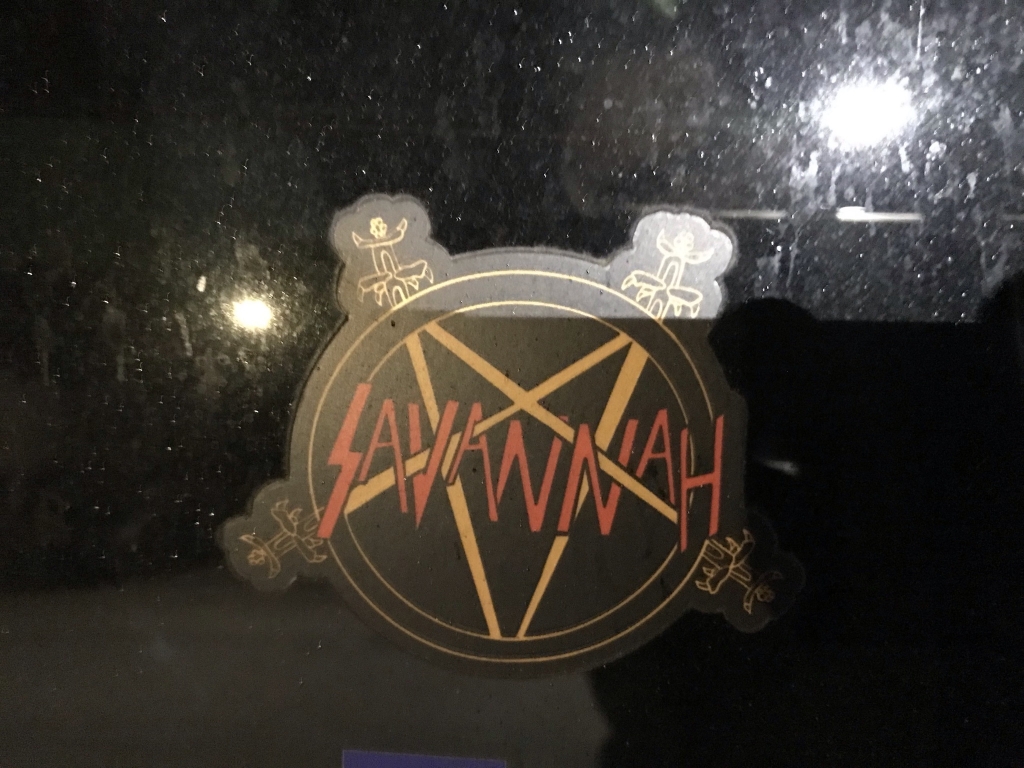After that unforgettable music festival, Suwannee Hulaween, I couldn't just go straight home and go back to work. For this reason I planned out a trip that would take up the whole week after the festival. Originally I wanted to spend that week in Germany, but because I had to get my passport renewed and waited too long to do it, I came up with an alternate trip that would also involve historic cities and train travel. After some research I decided on Savannah and Charleston, and stuck a night in Charlotte in there at the end.
Monday, November 1, 2021
Early on Monday morning, the whole festival was packing up and disappearing as quickly as it could. Workers were breaking down stages, and to my dismay, only one food stand was still open, which was the coffee stand. One food stand which had packed up and departed already had left behind a huge bowl full of leftover rice and beef on a nearby picnic table, and so I got a plastic fork and a paper plate from one of the other closed food stands and had a plate full of rice and beef for breakfast.
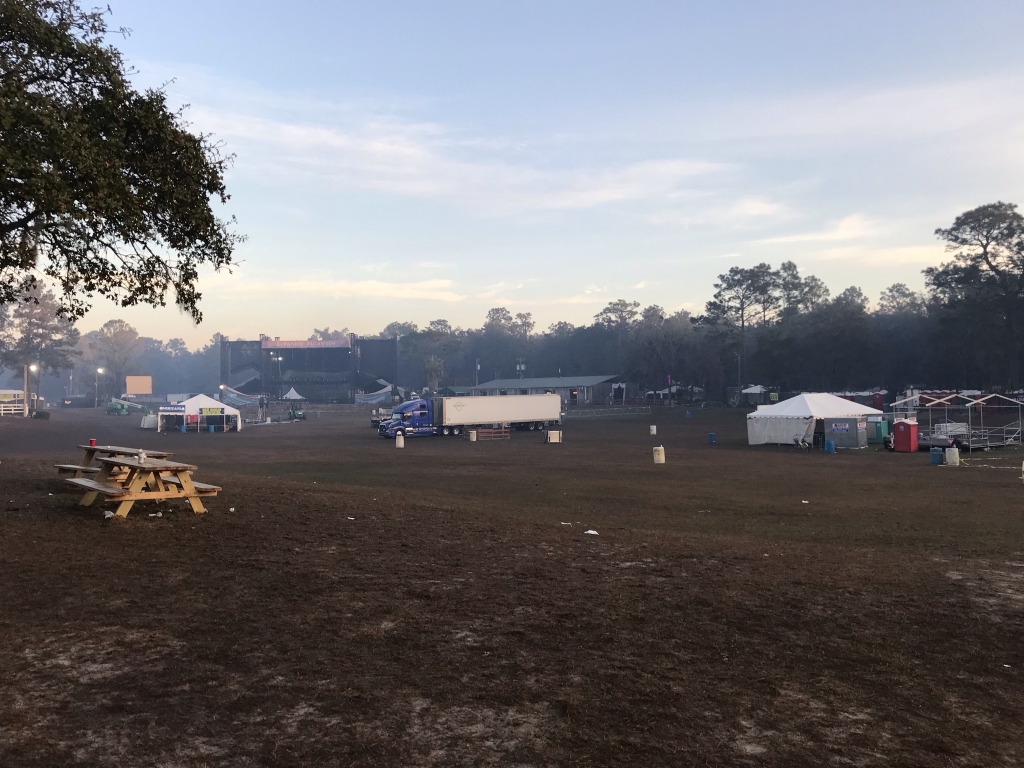
My tent was rather wet so I didn't fold it properly, I just bunched it up and stuffed it in my suitcase with the intention of spreading it out and letting it dry later. After everything was packed up, I was soon on the shuttle bus which spent an hour driving east to the Jacksonville airport.
At the airport, I once again unnecessarily took an Uber into the city, not noticing the bus stop there until after I'd ordered the Uber. My destination for this ride was an ordinary chain restaurant which I don't get to eat at often: Panera.
Finished with my big lunch salad at Panera, I now had a few hours to pass walking around the center of Jacksonville...
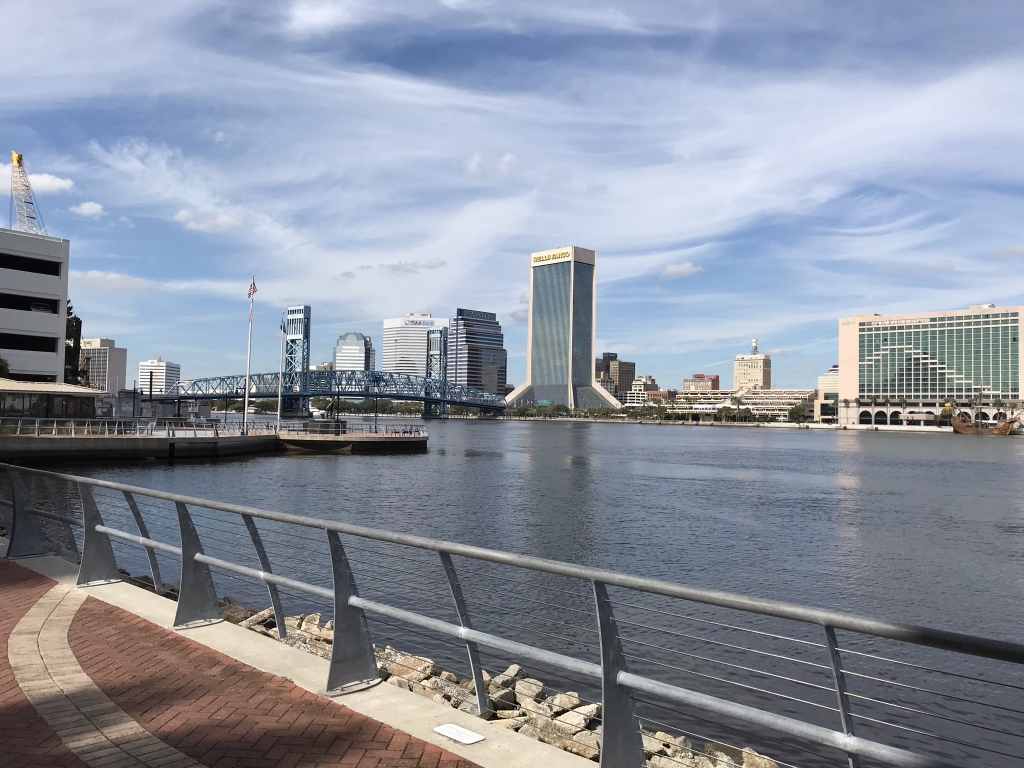
Jacksonville is on the Saint Johns River, and there are Riverwalks along both banks of the river. This was taken on the south bank of the river looking north; soon I would be walking across that bridge.
After walking north across the bridge, I decided to stop at a microbrewery that happened to be open then. This place was called Ruby Beach Brewing. Pretty good place for some local beers. Here I started with their Twin Finn Lager, which I liked so much I had a second one, and then something darker and a little bit sweeter, Redstone Meadery Black Raspberry Nectar. The background music was all classic '70s rock from bands like Rush and Blue Öyster Cult, stuff I used to listen to a lot more. This is a place I'd recommend if you're in the area and like local breweries; I liked the beer that I drank, and there was plenty more on the menu that I would have liked to try as well.
At that point there wasn't much time left, so I had another Uber take me to the train station. Jacksonville's train station was a small, uninteresting building not unlike most other stations that don't serve very many trains. In fact, it wasn't much different from a Greyhound bus station. This one sees four trains stop there daily so it's still a bit busier than a lot of the sleepy shacks you find out west. Unlike every other Amtrak station I've been in, they actually had a kind of procedure for boarding. After I walked in the station and checked my baggage, I tried to just walk out to the platform and wait there just as I had so many times during the summer at BWI. But someone stopped me, because apparently at JAX you can't go out to the platform until the train gets there and the people working there say you can. Not only that, everyone had to line up single-file behind the door as the train was pulling in, and only then, with everyone lined up and the train stopped, did someone open the door and let us out. And the rules didn't end there: this train had assigned seating.
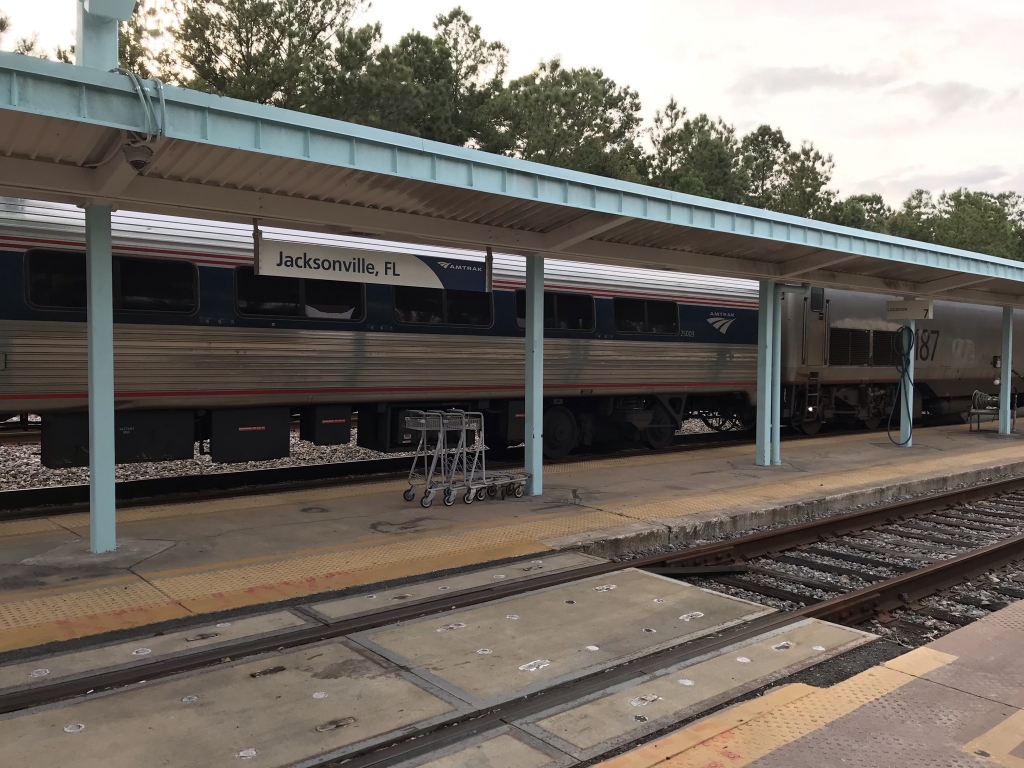
Amtrak's Silver Meteor waiting on the platform in Jacksonville. This train travels a long daily route between Miami and New York City, stopping here, Savannah, Charleston, Richmond, DC, Baltimore, and Philadelphia, among others along the way.
The train I had just boarded, Silver Meteor, was almost completely full, much like the Northeast Corridor trains I'd ridden during the summer. And just like back then, I was OK with that because it meant that large amounts of people actually ride these trains, that I'm far from the only one who thinks of trains as a viable means of getting from one city to another. During the ride I had a book with me to pass the time, Walter Isaacson's biography Benjamin Franklin: An American Life which I'd bought in Philadelphia in August, and had been gradually slogging through for the last two months and was finally reaching the end.
By the time I got to Savannah, the sun had set. The train station was some distance outside the city center so I had a Lyft take me to a restaurant on the western edge of the old city, close to where the Airbnb house I'd reserved was. It was at this time I decided I'd spent enough money on Uber and Lyft and that from then on, I'd use public transit like I usually do when visiting cities.
After stepping out of the Lyft, I was really hungry for dinner, which is why I'd had the Lyft take me to a Chinese restaurant. It was one of those typical hole-in-the-wall "Chinese" places in a strip mall, and it was named Egg Roll King. Here I got a huge box of onion/pepper beef and fried rice. It was delicious but there was so much of it, there was no way I was going to eat it all for dinner. I ate about a third of it and saved the rest for future meals.
Now, finally, to check into the Airbnb house. It was pretty easy to find, and the email I got from the owner told me the unlocking code to enter the front door. This house, like those immediately surrounding it, was the same kind of house that was commonly built in the Northeast and Midwest early in the 20th century: about as long as it is wide, with a front porch, two stories, and on top, a smaller attic with windows. It wasn't dissimilar to the house some of my relatives in New Jersey live in. All the bedrooms were on the second floor and there was one other traveler staying there at the time.
After stepping out one more time to make a run to a convenience store, I finally got to do something I couldn't do at Hulaween: take a nice, long, hot shower. It was long and hot enough that the bathroom filled with as much steam as a sauna. And when I was finally done with the shower, I climbed into the bed and slept for nine hours straight.
Tuesday, November 2, 2021
After waking up with some leftover Chinese food for breakfast, I began my exploration of the city. At this point, we have to take a look at the way the historic core of Savannah is laid out:
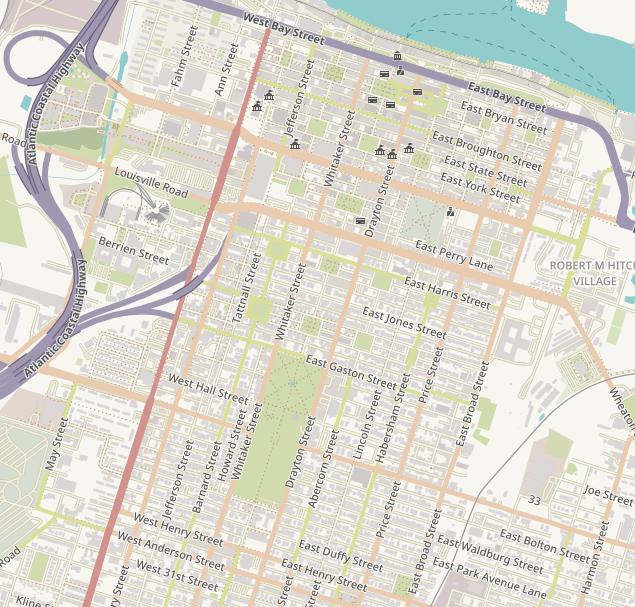
This map is from OpenStreetMap's Humanitarian view. I really love how this city was planned. See all those little green squares? Those are all small public parks. The much larger green rectangle between Whitaker and Drayton Streets is the biggest park, Forsyth Park. This is how the planners first laid down Savannah's foundations in 1733. Dating from that long ago, it was built for people before cars. As you walk around this historic city center, as you pass from one green space to another, you'll see not only varying styles of homes but also plenty of shops, restaurants, and cafés. This is exactly the kind of city we don't have enough of in America.
I wasn't sure where to go first so I just started walking east from the Airbnb house. First, I got an Americano from a café called Foxy Loxy. From there I turned north and before I knew it I was in Forsyth Park.
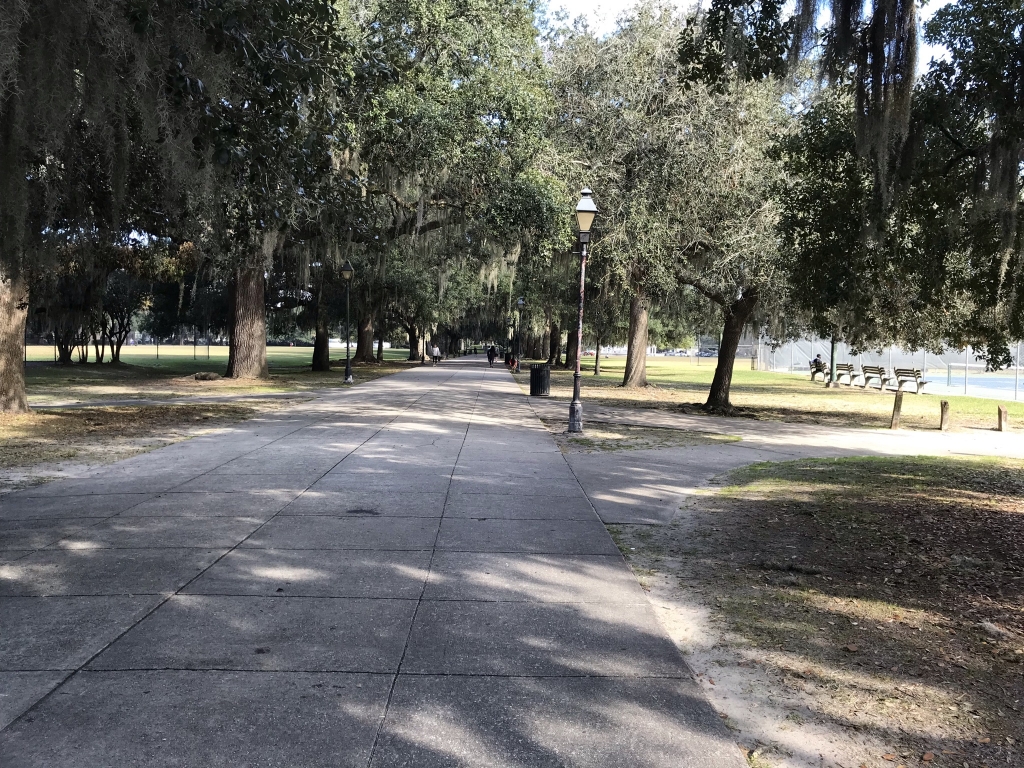
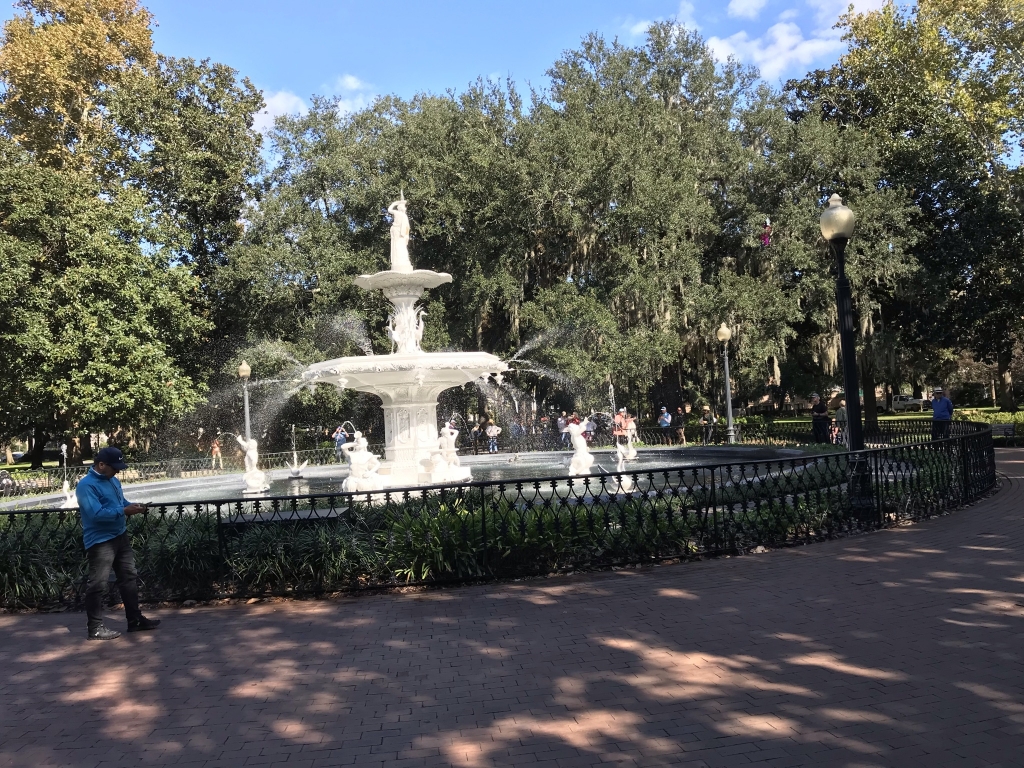
Most of the morning I spent walking through and between the park squares. Every one of the squares had a monument or a memorial in its center.
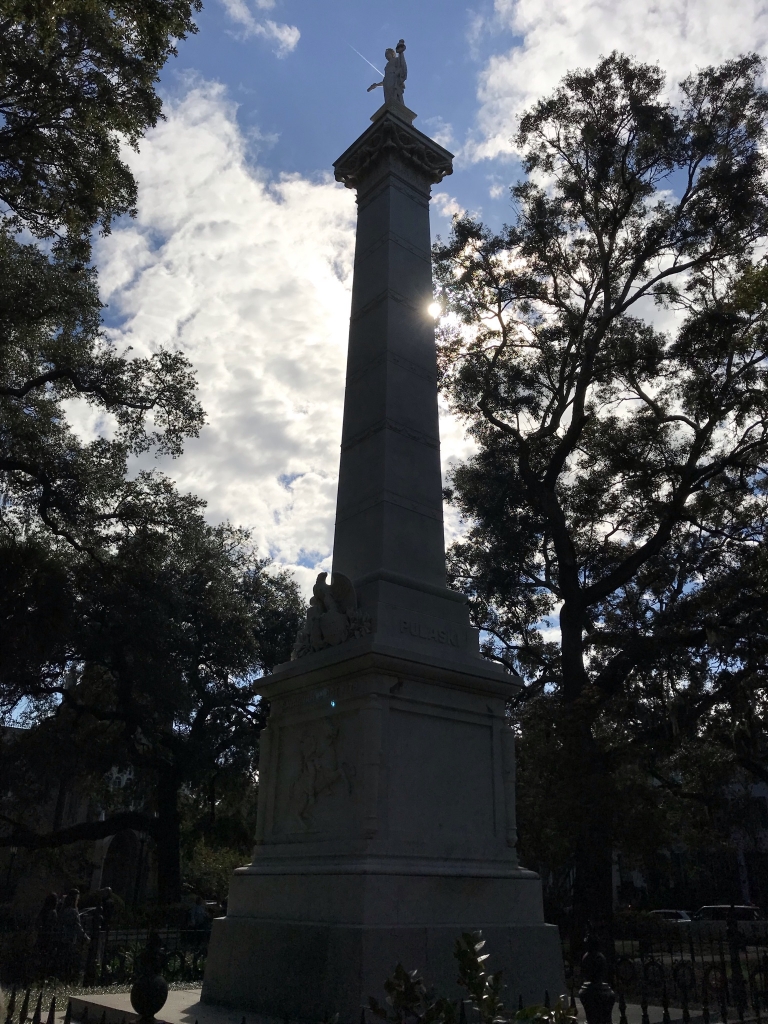
In the middle of Monterey Square is a monument to Casimir Pulaski, the Polish general who fought on the American side in the Revolution and died here in Savannah on October 11, 1779, during the unsuccessful siege of the British-occupied city.
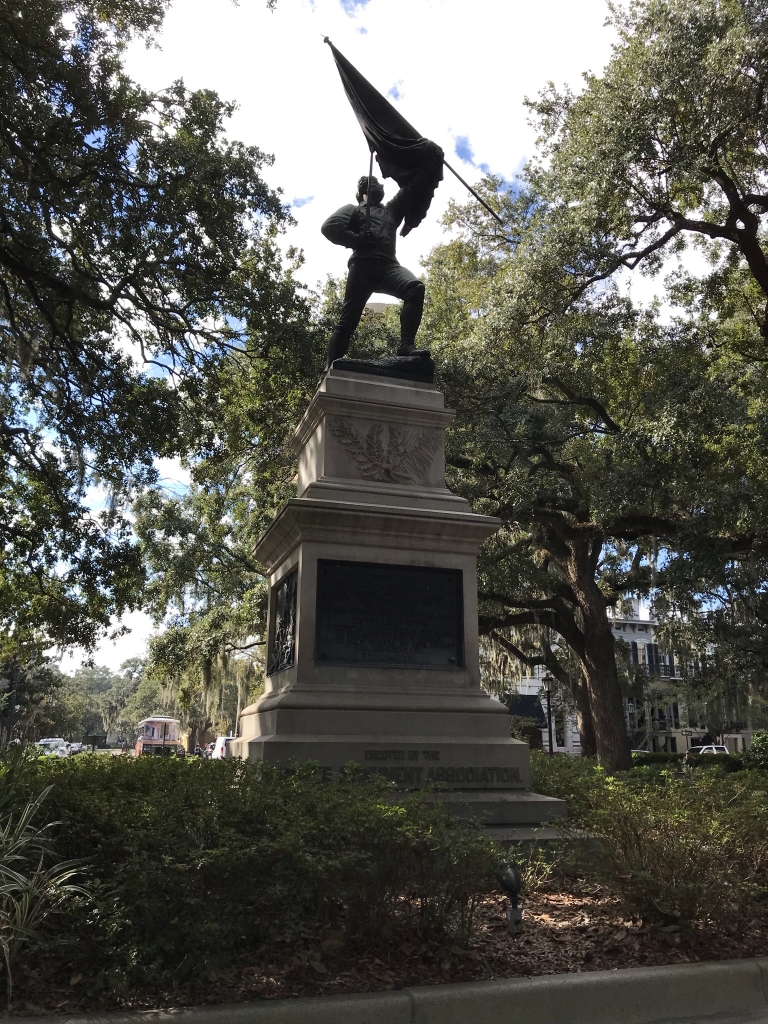
In Madison Square you can find this statue of Sergeant William Jasper, who also died in the siege of Savannah. Jasper was mostly remembered for recovering the South Carolina flag, during an earlier battle, and holding it up while under fire until a new staff could be found for it. He was killed during the siege on October 9, 1779 and this memorial went up a century later in 1879.
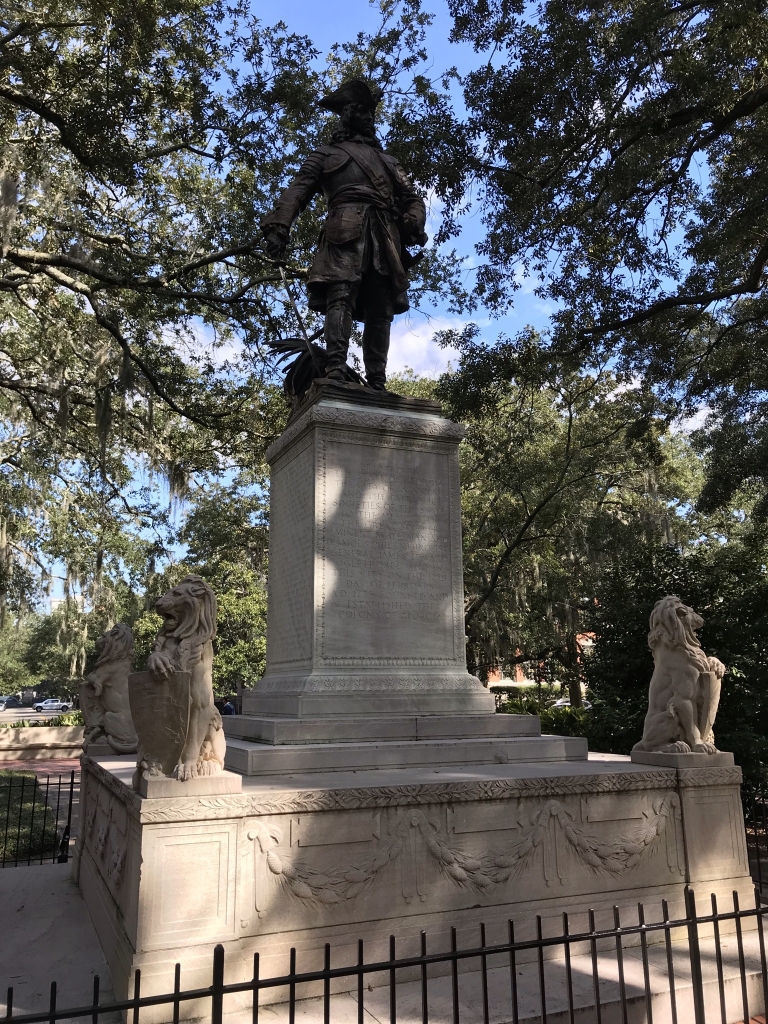
This is the founder of Georgia, James Oglethorpe, whose statue can be found in Chippewa Square.
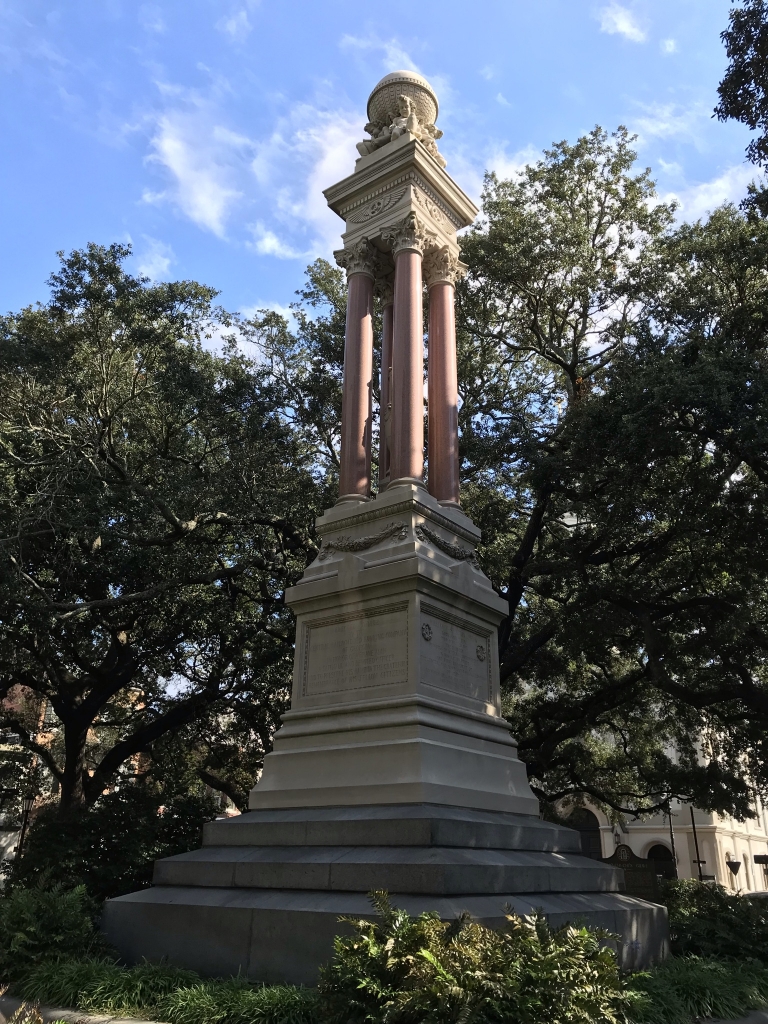
In the center of Wright Square is a monument to William Washington Gordon, who founded the Central Railroad and Banking Company of Georgia in 1833. Underneath it is the grave of Tomo-chi-chi, chief of the Yamacraw tribe, who was buried there in a ceremony in 1739. The aforementioned James Oglethorpe was one of the pallbearers.
So they buried the body of the Yamacraw chief there...and then over a century later put on his grave a monument to someone else.
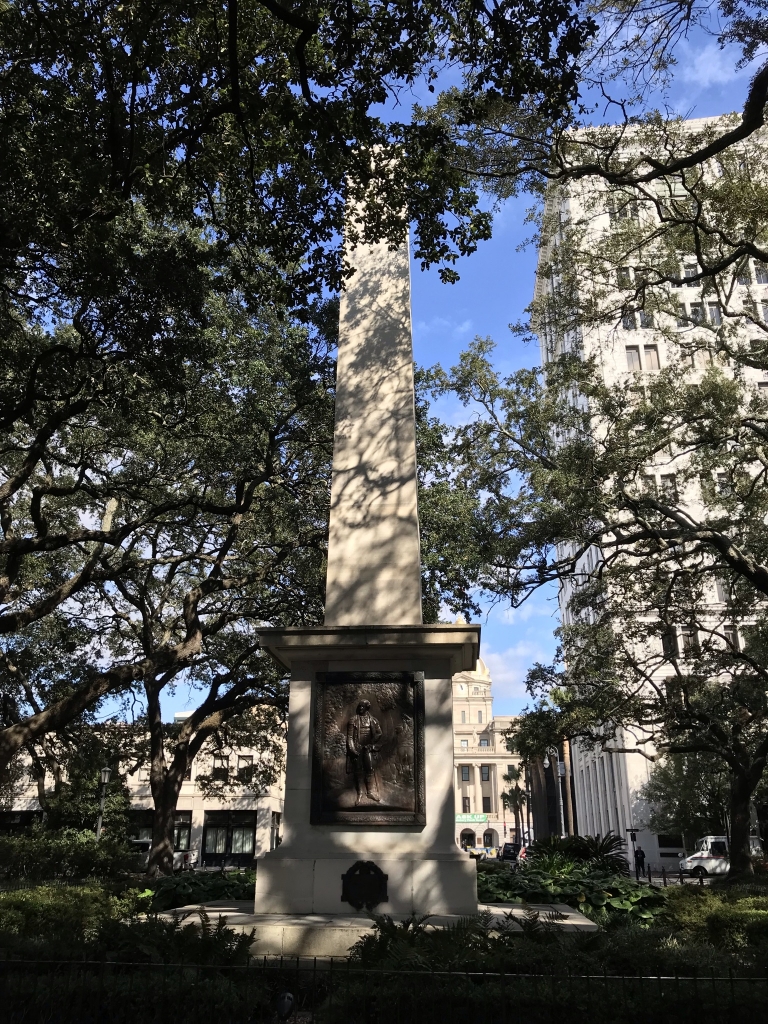
This isn't just a monument to Nathanael Greene, he's actually buried under it, here in Johnson Square. Greene was one of the most successful generals in the Continental Army during the Revolutionary War. The towns of Greensboro, North Carolina and Greenville, South Carolina were both named after him.
In between the squares I walked past many restaurants, cafés, and shops, as well as houses of varying sizes and styles.
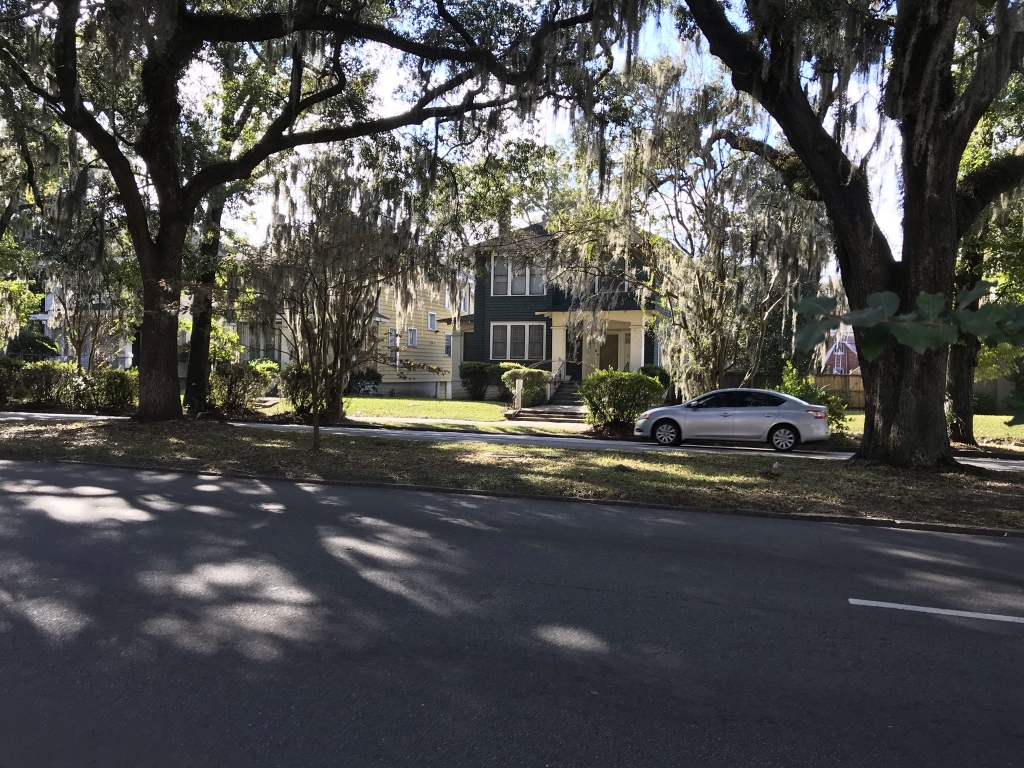
Many houses are like these, two-story detached homes that look like they were built around the 1920s. The Airbnb house where I spent the nights was in this same style.
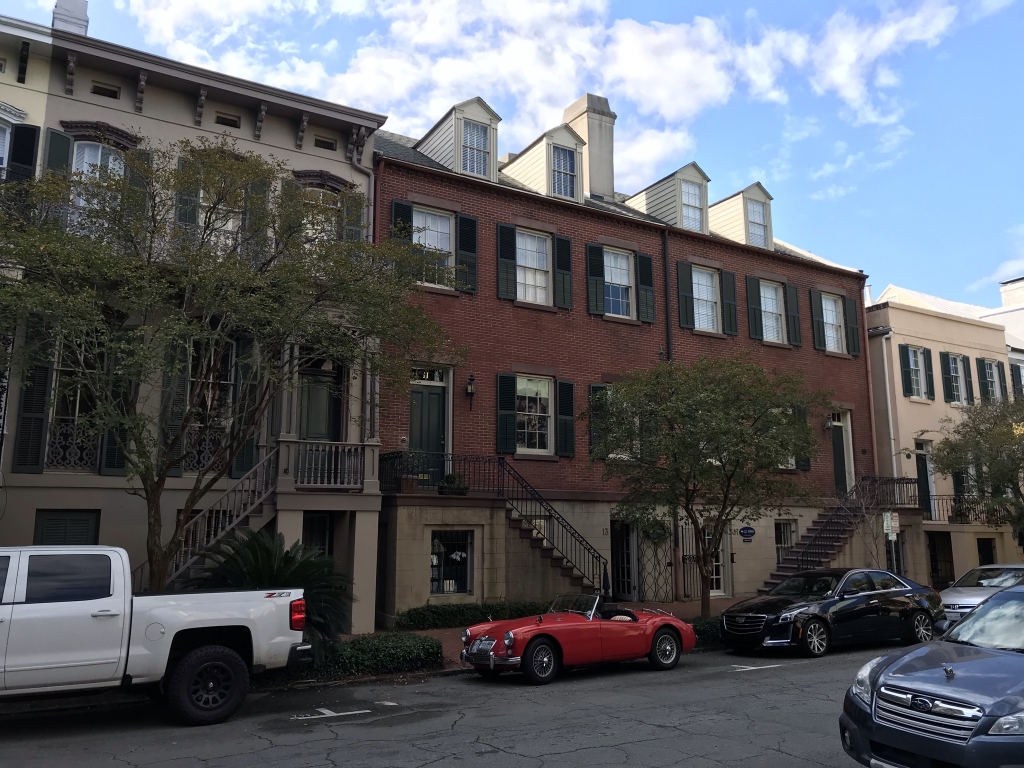
In some areas you'll see row homes that wouldn't look out of place in a northeastern city.
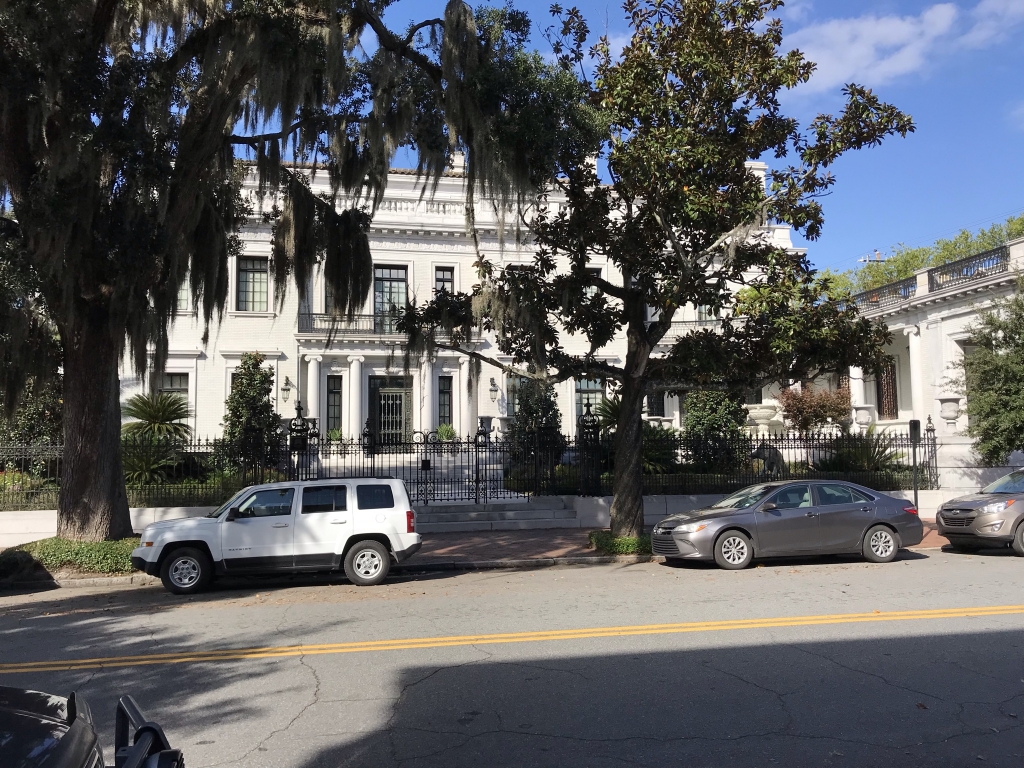
There are also mansions like this one, the historic Armstrong Kessler Mansion on Bull Street in between Forsyth Park and Monterey Square.
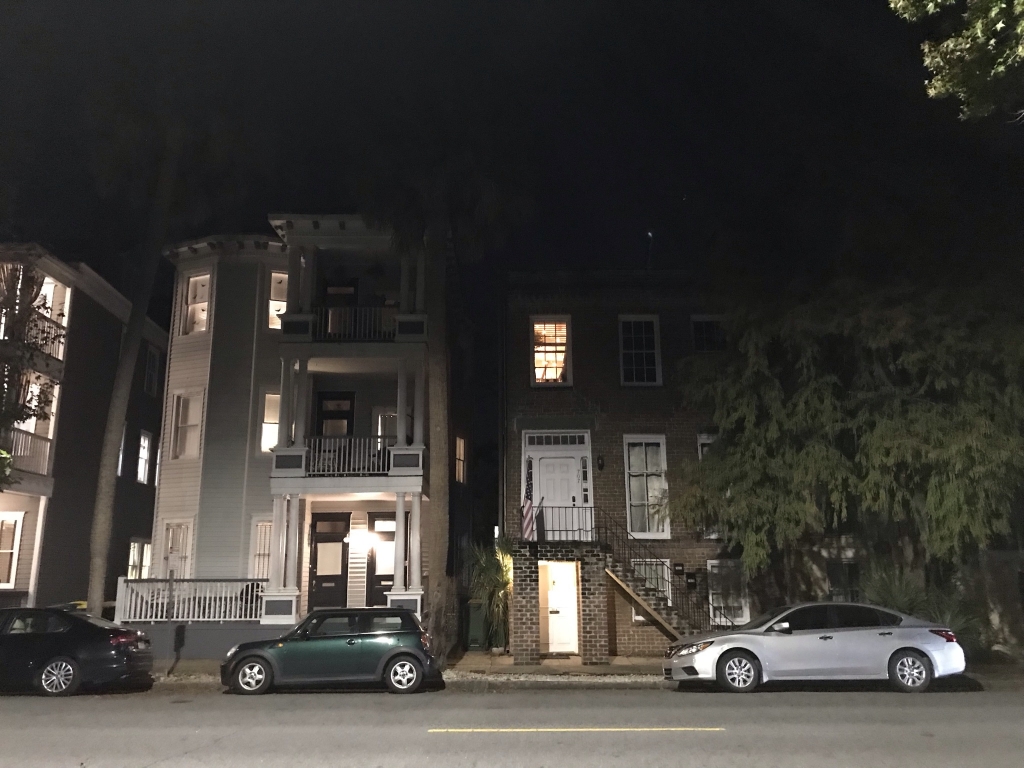
These homes reminded me of certain neighborhoods I saw in DC. Obviously I didn't actually take this picture in the morning.
After all this time walking around and admiring everything, I was soon on the Riverwalk lining the Savannah River.
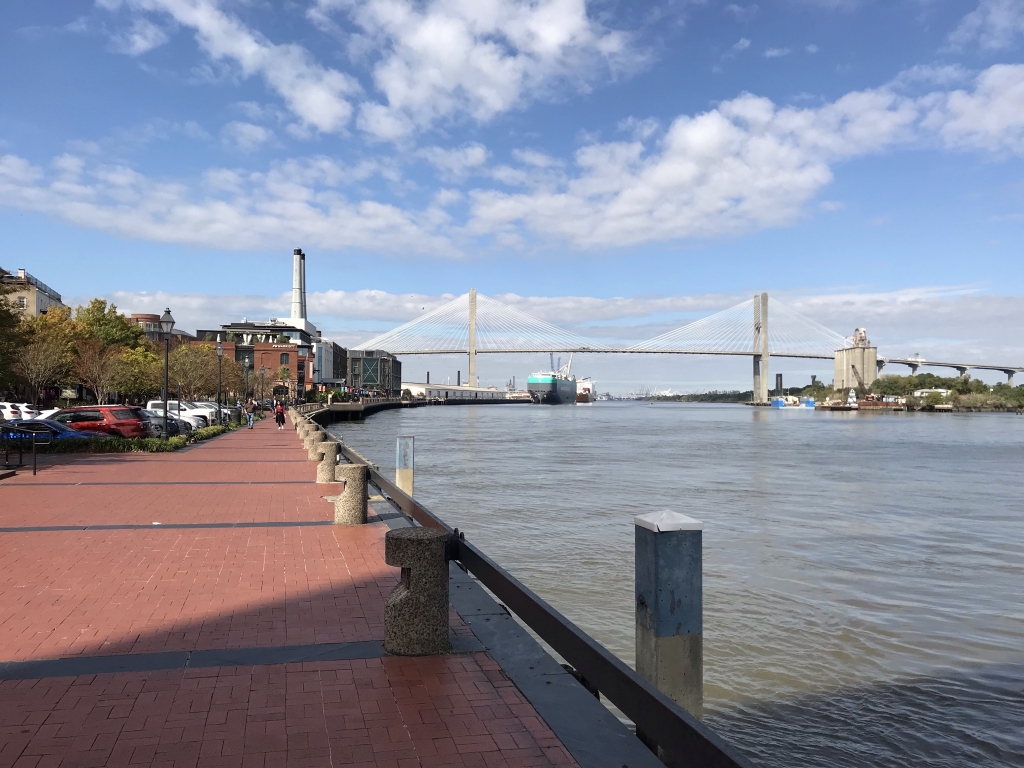
What to do for lunch? I really wanted some seafood and there were plenty such options on the Riverwalk. The place where I decided to stop was called Fiddler's Crab House. There I had a Coastal Spinach Salad with red snapper for lunch. I don't think I'd ever had that kind of fish before. Along with that I got my first beer in Georgia, a pint of Silver Bluff Needlerush Hefe, which is brewed in Brunswick.
There were some museums in Savannah I wanted to check out, but didn't have time for all of them. First I went to the Prohibition Museum. As the name indicates, this is a museum where you can learn all about the era from 1920 to 1933 in which alcohol was illegal in the United States.
It starts in the years just before Prohibition, when prohibitionists were campaigning vigorously to outlaw alcohol. Knowing a bit about the history, I knew that the prohibitionists were surprisingly diverse, coming from across the spectrum of society, and their numbers included liberal social reformers, feminists, and early civil rights activists, in addition to white supremacists and conservative fundamentalist Christians. Fundamentalists such as...
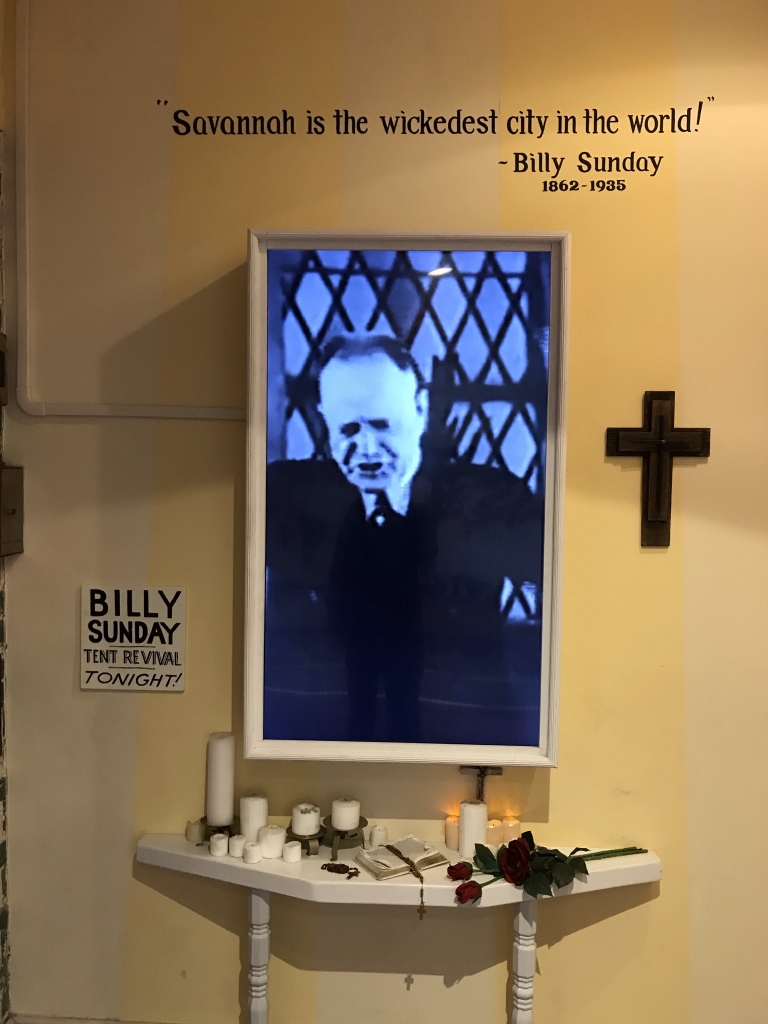
This is Billy Sunday, probably America's first celebrity evangelist, who was known for preaching fiery, theatrical sermons at his massive tent revivals. He was one of the most ardent campaigners for alcohol prohibition.

Nothing like appealing to people's prejudices to gain their support. This is a pro-prohibition ad from the first World War in which Germans were the enemy, while their German-American cousins owned most US breweries.
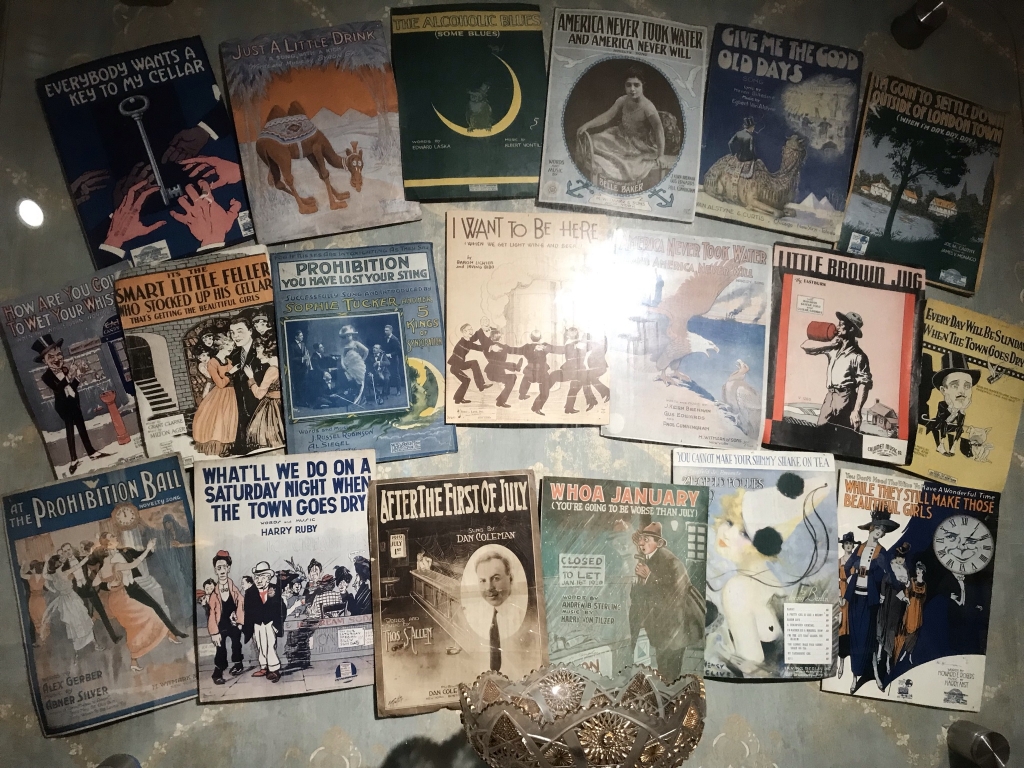
Sheet music for a bunch of Tin Pan Alley songs lamenting the impending alcohol ban.
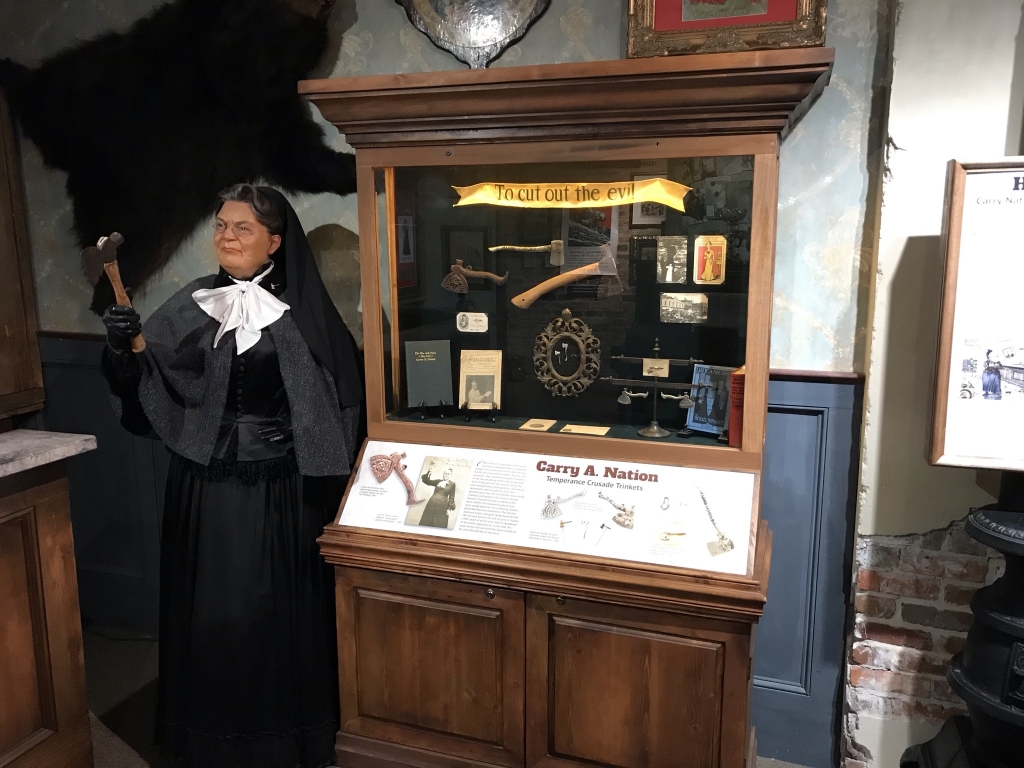
Ever heard of Carry Nation? She became a celebrity for her radical anti-alcohol activism. Thinking the Women's Christian Temperance Union--one of the leading prohibitionist organizations--to be too passive, she waged a campaign against booze which involved her famously shutting down saloons by smashing everything in them with an axe. She did, however, have a bit of an understandable back story, having lost her husband to alcoholism.
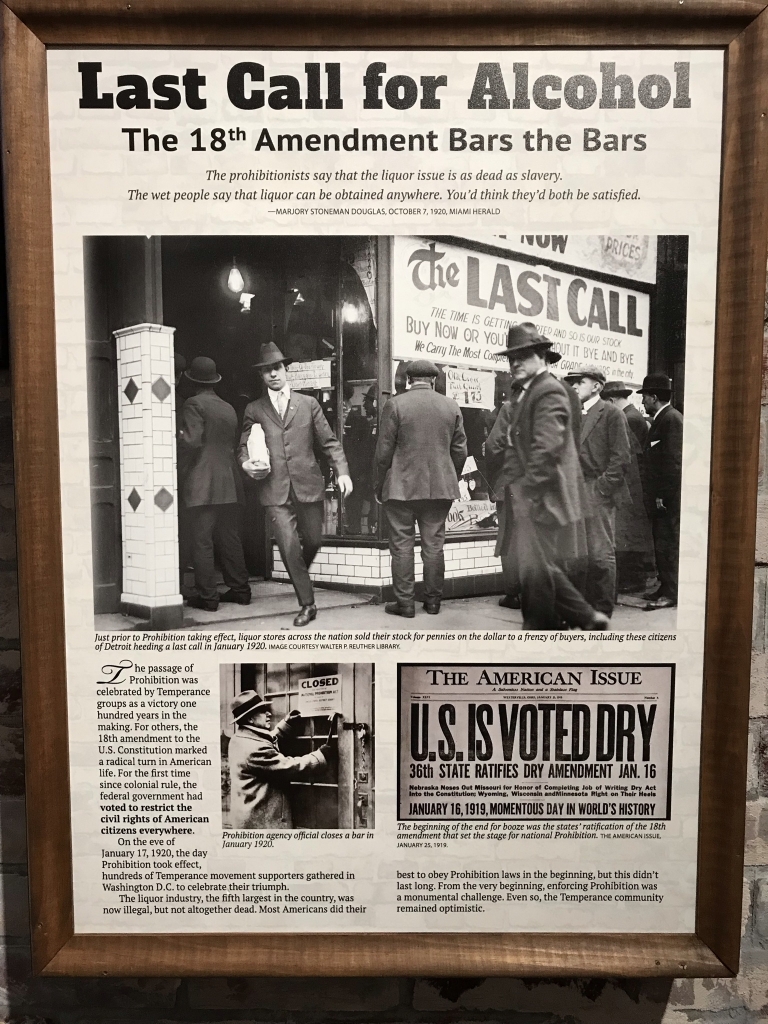
The day before Prohibition went into effect, everyone was stocking up, buying all the beer, wine, and booze they could.
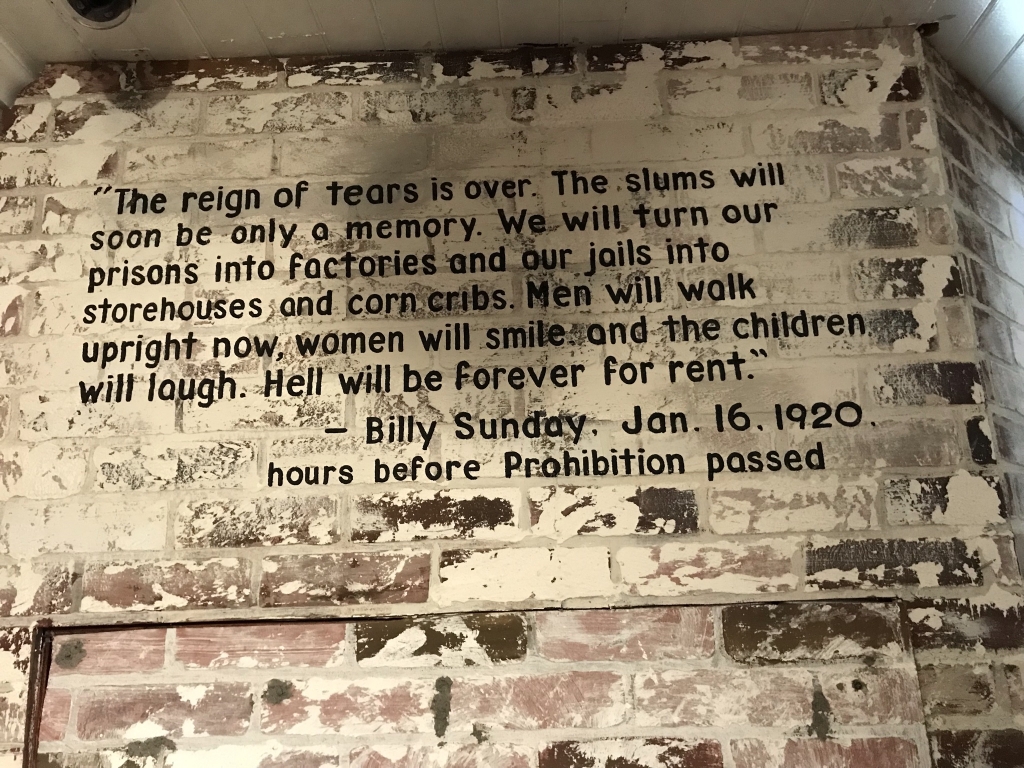
This isn't exactly how the ensuing decade panned out.
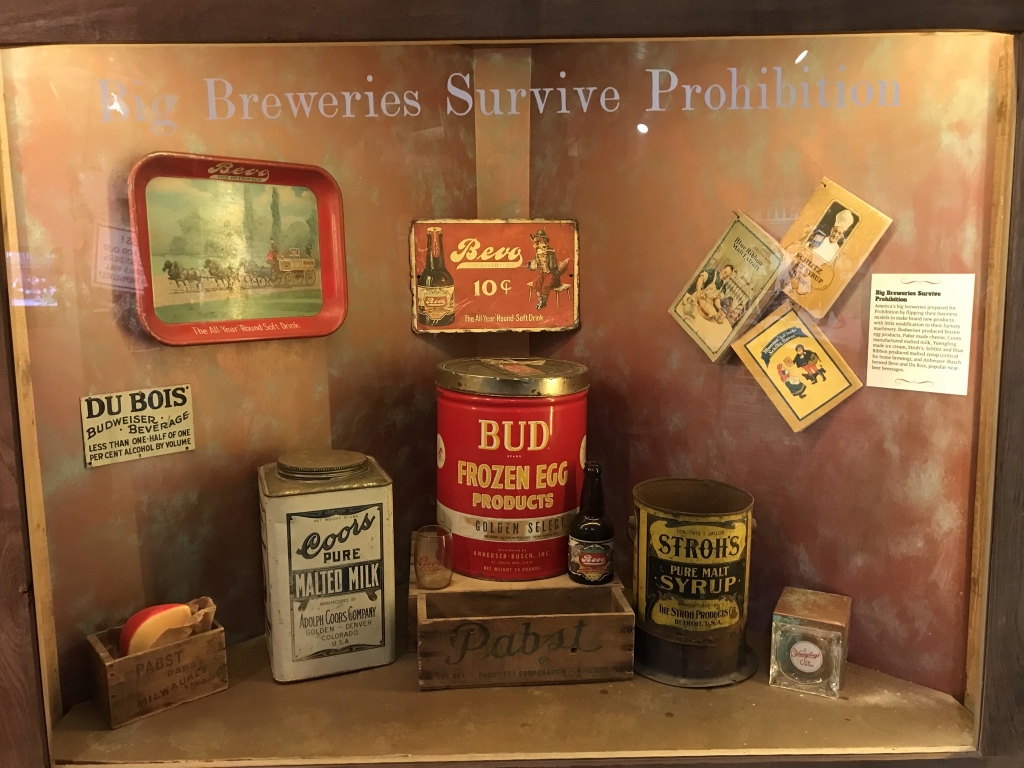
Here we can see how many American breweries survived Prohibition, by making other products instead. Not all the breweries could survive this way, though. As I learned from Beer in America, a book which I bought a couple months earlier in Philadelphia, only those who were big enough and had enough money could successfully transition to another business. Many more smaller American breweries that had been in operation for over a century had to shut down permanently. This makes me wonder what American beer would be like today if Prohibition never happened.
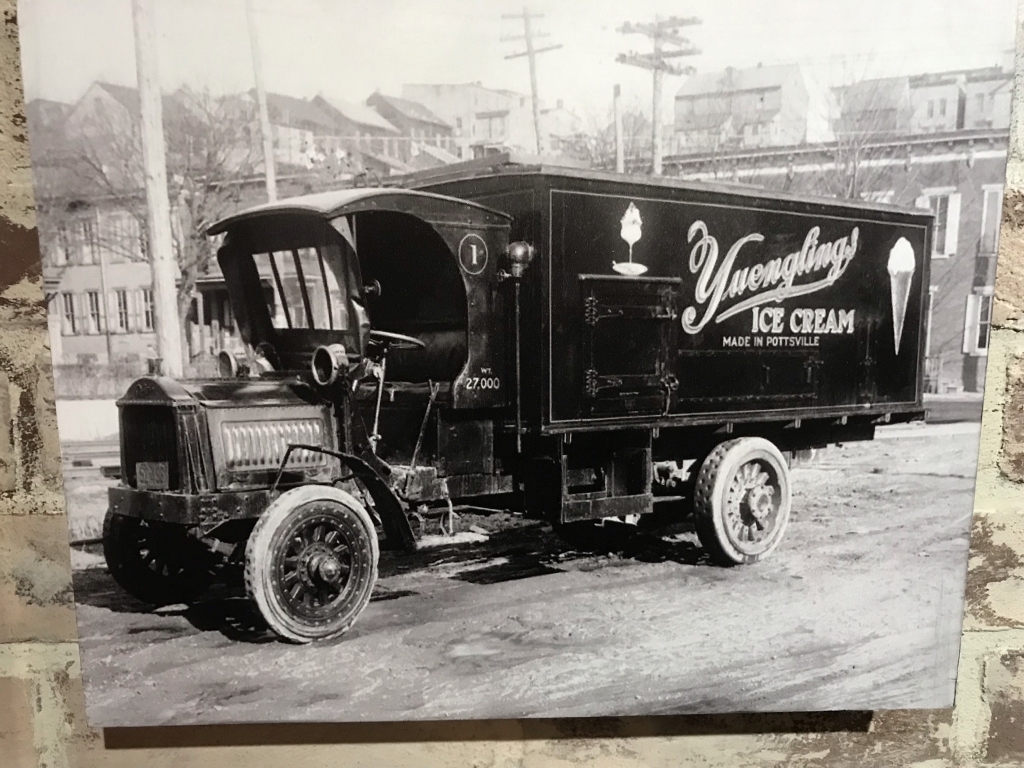
Pennsylvania's Yuengling, which today is the oldest operating brewery in the US, stayed afloat during Prohibition by making ice cream.
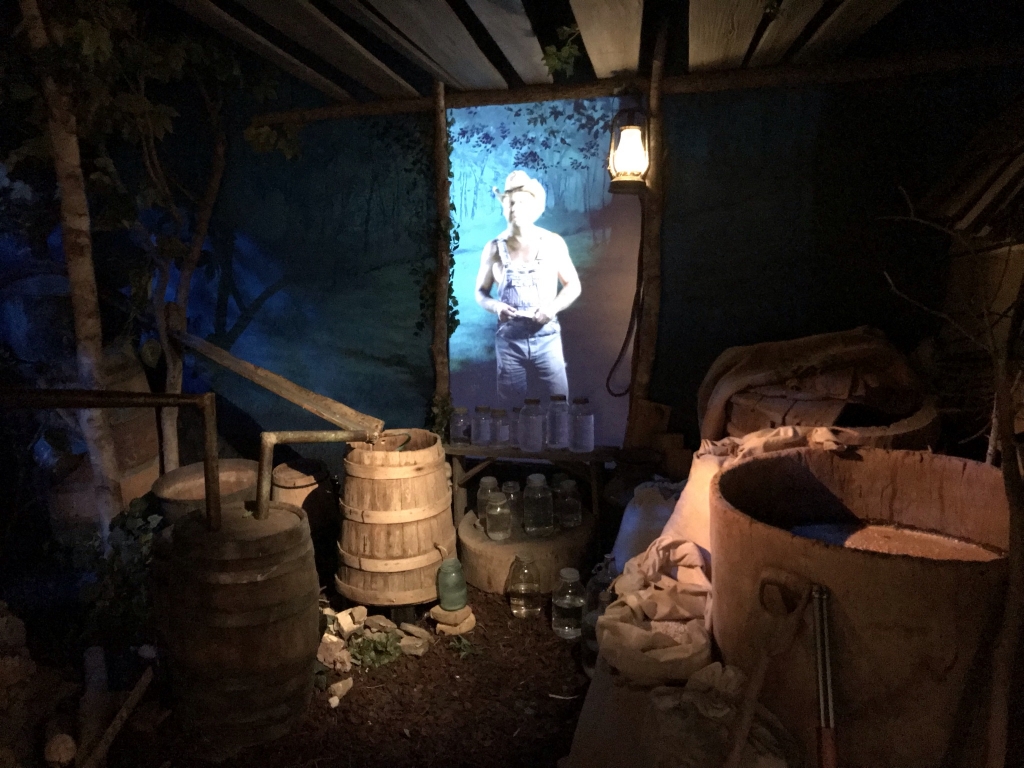
On this screen is a historical interpreter playing the role of a moonshiner. Ever since the 18th Amendment went into force, business is booming and he's been working that still all night!
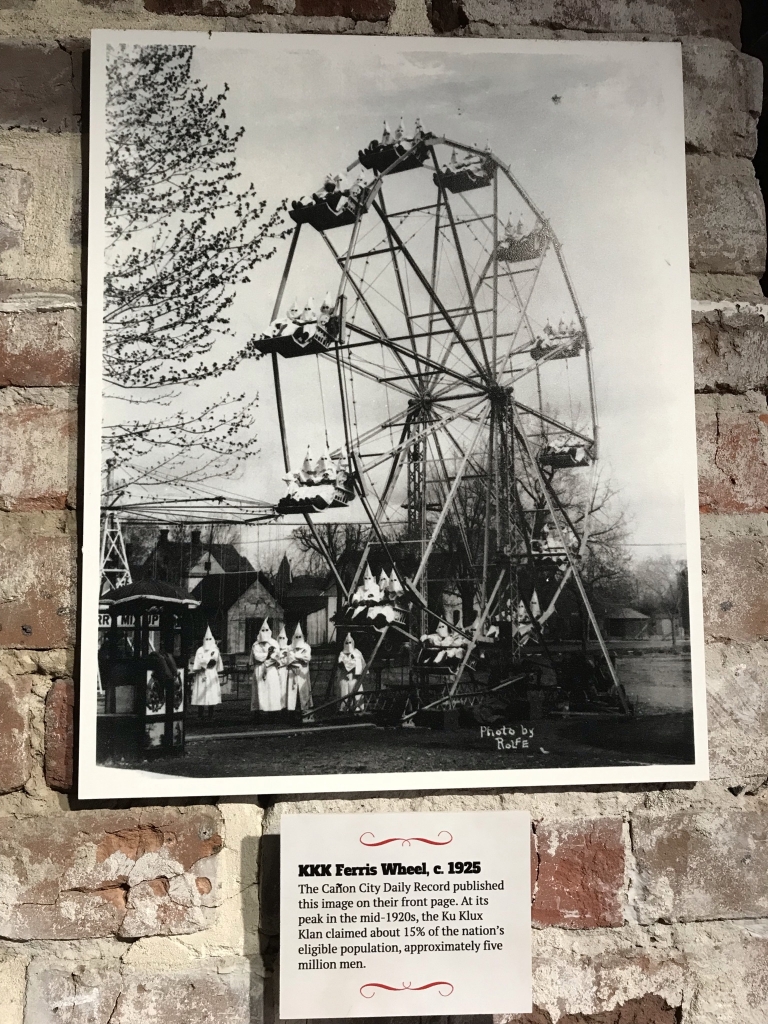
Well, this is certainly one of the most surreal photos I've seen. The Prohibition 1920s were also the heyday of America's most notorious white supremacists, the Ku Klux Klan, whose membership was as high as five million men--15% of the adult male population of the US--in the last half of the decade. As another sign says, they were "Prohibition enforcers" who, on top of their usual acts of racist violence, used Prohibition as an excuse to terrorize German and Irish immigrant brewers, intercept illegal alcohol shipments, and raid speakeasies.
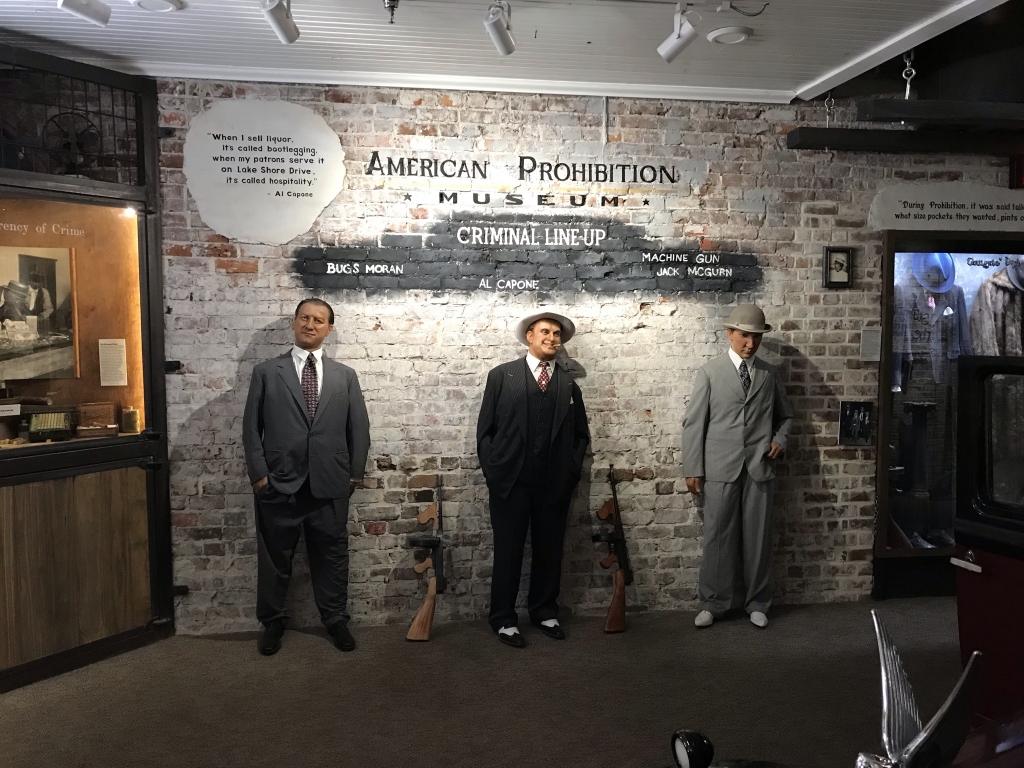
The era was also the heyday of mobsters like Al Capone, who ran the illegal liquor trade since all the legitimate businesses were shut down.
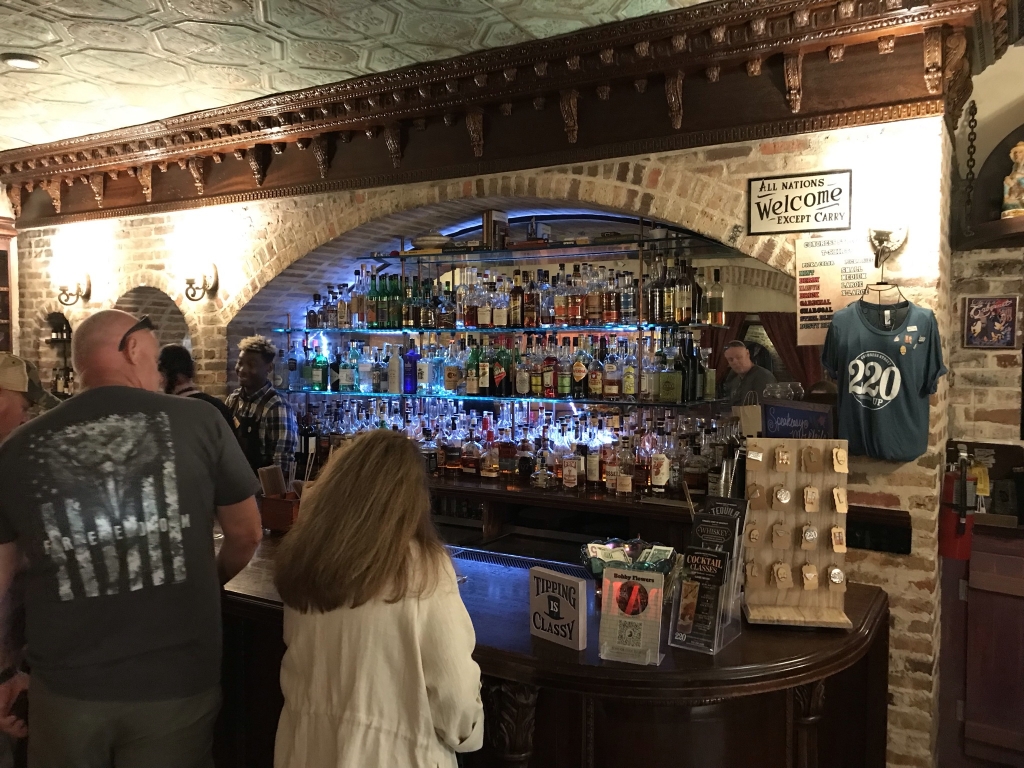
The museum also has a bar meant to look like a speakeasy. I had some kind of cocktail here which was made with absinthe.
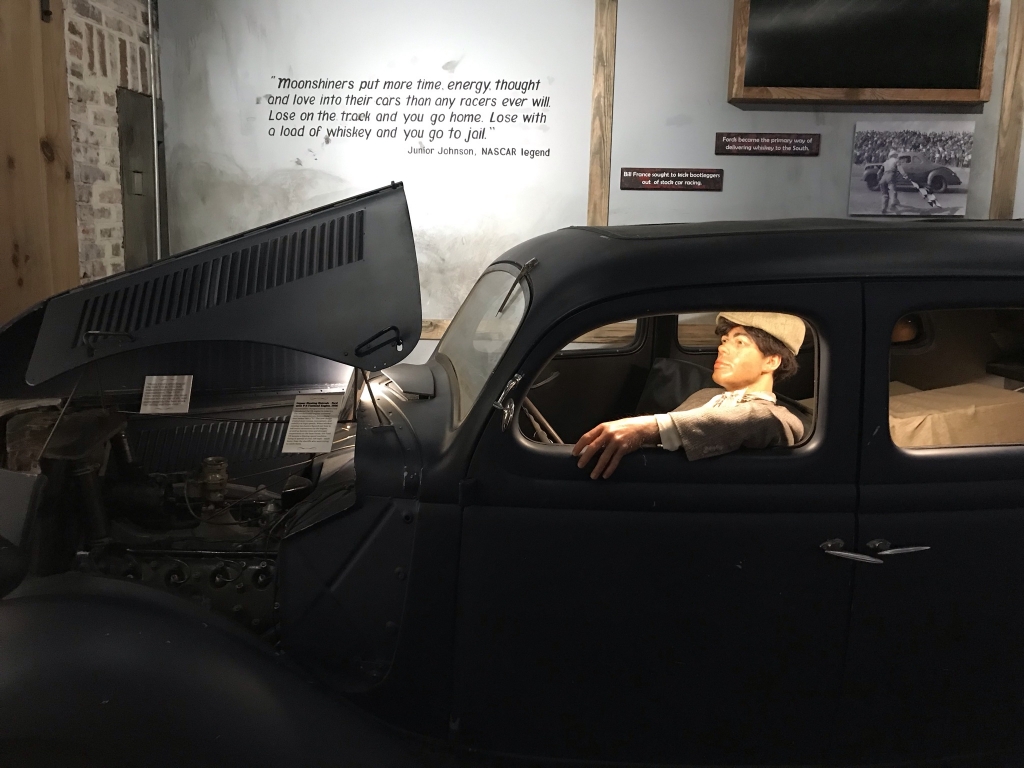
Here, near the end of the museum walkthrough, we find out about one more unintended consequence of Prohibition. Moonshiners modified their cars for speed and power so they could outrun the police while loaded down with illegal booze. Eventually they started racing each other for fun, which gave rise to the sport of stock car racing.
The Prohibition Museum had a gift shop. Here I bought a sign, to hang on a wall at home, which says "Party like it's 1933" on it with a picture of two people's hands clinking beer mugs, along with a beer coaster that looks like a miniature wooden cargo pallet with "I like my nights cold and drafty" written on it, and finally John Berendt's novel Midnight in the Garden of Good and Evil. I'd found that same book in the bedroom where I was staying in the Airbnb house, flipped through it a bit and found it was about Savannah, and decided it was interesting enough to buy here.
Months later I read the whole book during long cross-country train rides. I really liked it. It's based on all the experiences the author had while living, first temporarily and eventually permanently, in Savannah throughout the 1980s. The first half of the book introduces all the interesting people he got to know there, while the second is all about the unprecedented four murder trials of the socialite Jim Williams. I'll review this in more depth in my blog about that trip.
After the Prohibition Museum, I had time to visit one more: the Ships of the Sea Maritime Museum.
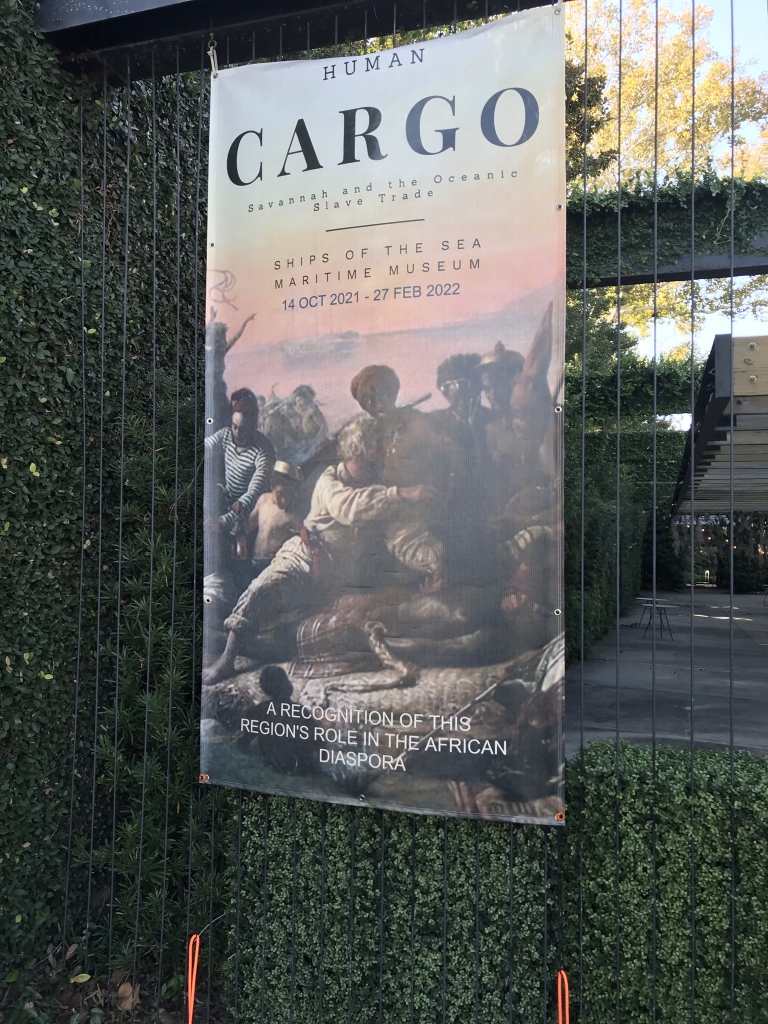
There was a special temporary exhibition going on here, Human Cargo. It seems that before the transatlantic slave trade was outlawed, Savannah was a major point of entry for many of the slave ships bringing Africans across the ocean in chains.
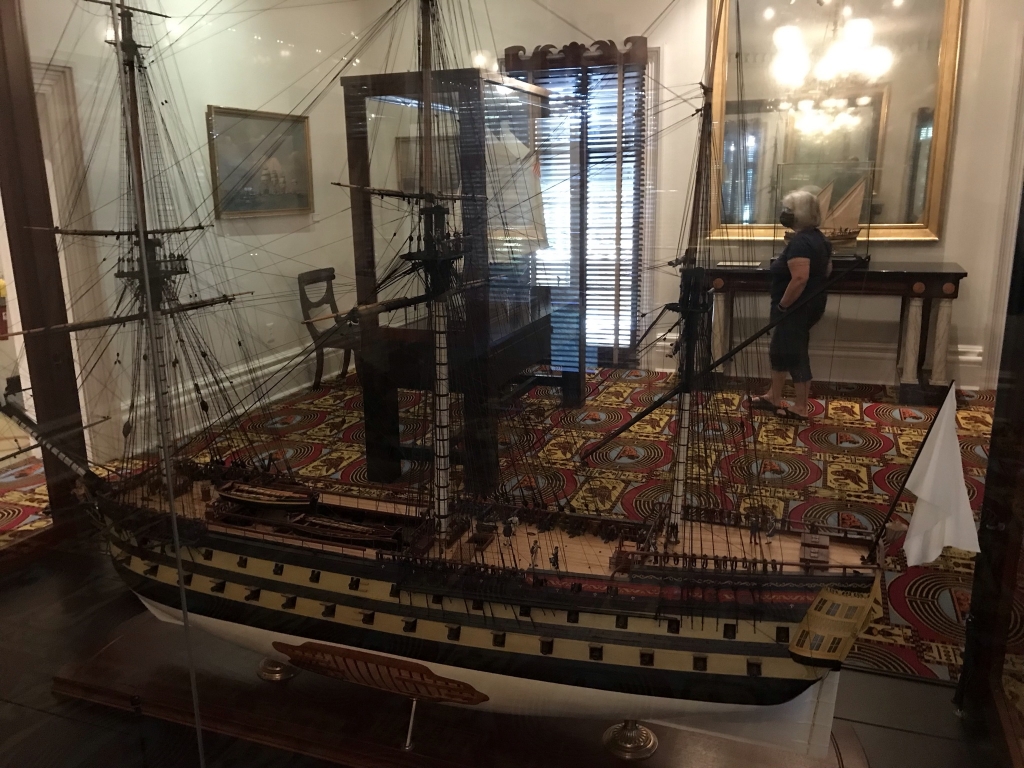
The museum is full of models of ships of various eras, all built to the same scale. This was a French ship, Languedoc. During the Revolution, France was America's closest ally, and this ship, as the flagship of Admiral Charles Henri Comte d'Estaing, was one of 22 French ships that joined the American navy in the unsuccessful siege of British-occupied Savannah in September 1779.
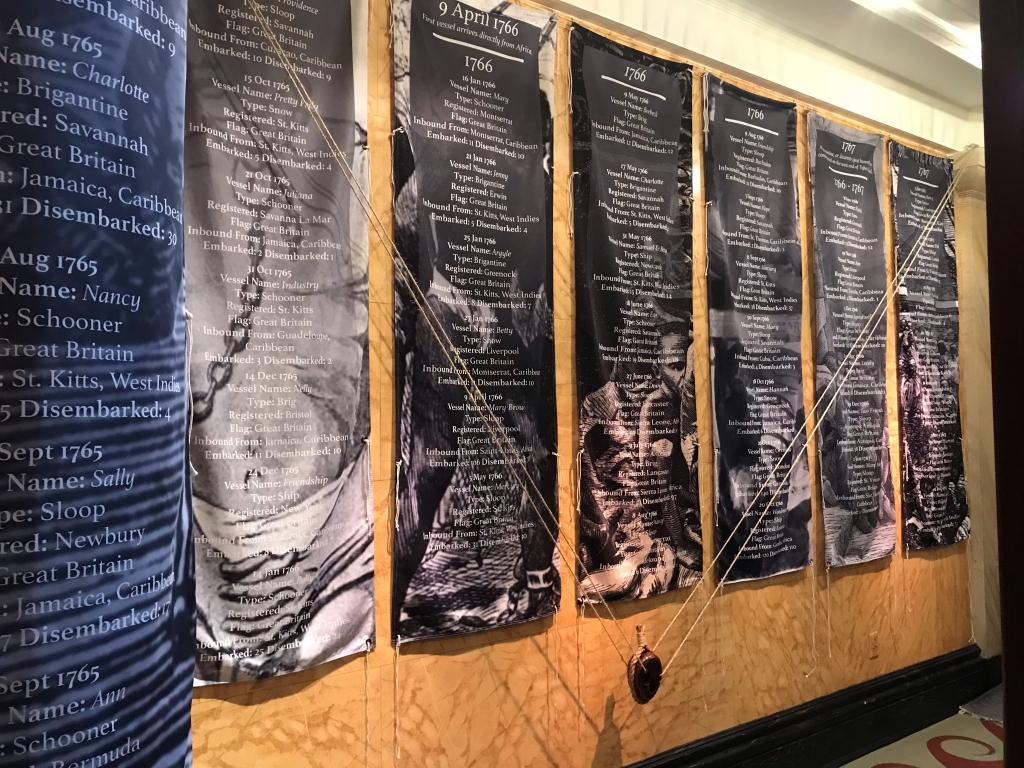
Now we're in the Human Cargo exhibit. All over the walls you can see banners on which are printed records of every single slave ship that docked in Savannah. For each one you see the date the ship arrived, its name, what type of vessel (brig, sloop, schooner, etc.), what city it was registered in, what country's flag it sailed under, from where the ship started its voyage, how many captured Africans embarked at the beginning of the voyage, and how many disembarked at then end--always a lower number.
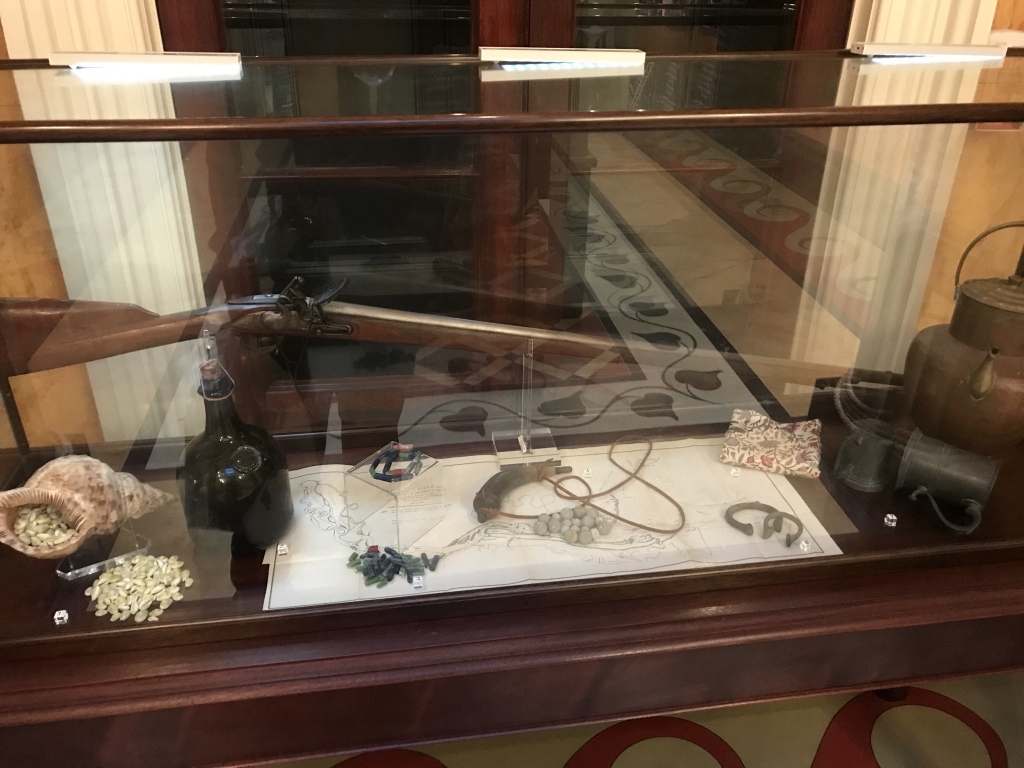
The items in this case, as a nearby explanatory sign says, were "articles of the trade." These were all goods, in demand in west Africa, with which European slave traders would barter for slaves. Here you can see cowrie shells, rum, Venetian glass beads, guns, and kettles. The rum is worth a closer look. It was made in Rhode Island, where most slave ships sailed from during colonial times. A nearby sign said that Rhode Island sent 519 ships to west Africa during that era while all others combined sent only 189. While we mostly associate slavery with the south, and it was always most widespread there, the north only abolished it after the Revolution. Rhode Island played a particularly important part in the slave trade, not only with the many ships the colony sent, but with its rum which was the traders' preferred currency.
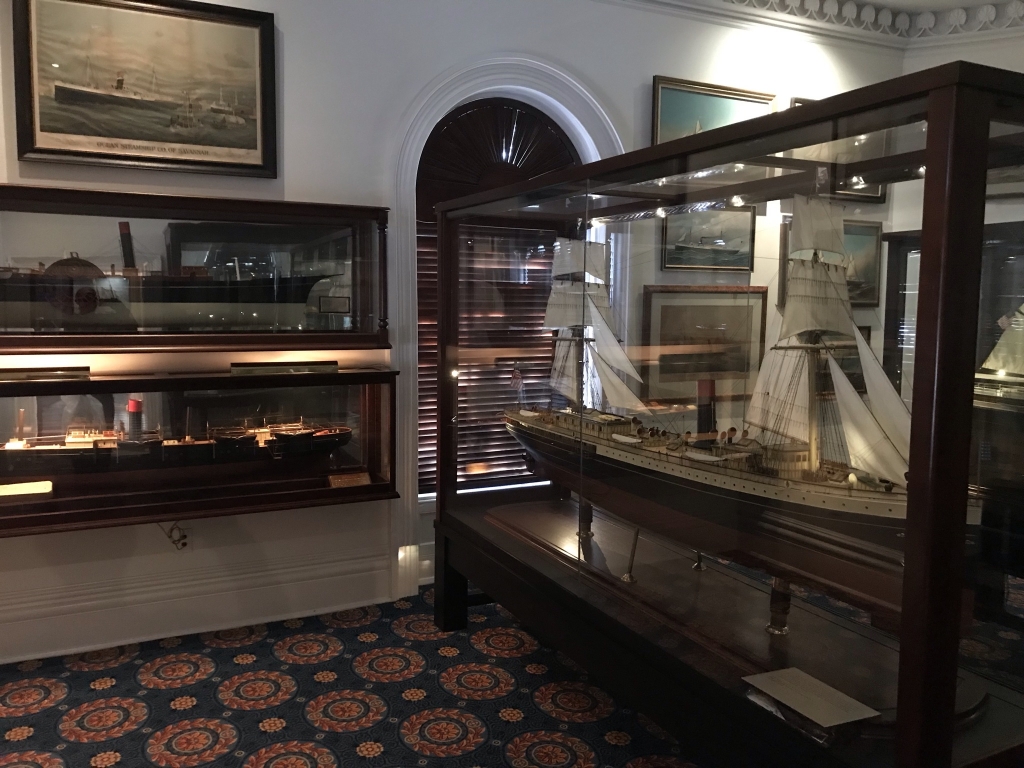
These are all from the steam era. I always thought it was interesting how so many steam-powered ships in those days still had sails.
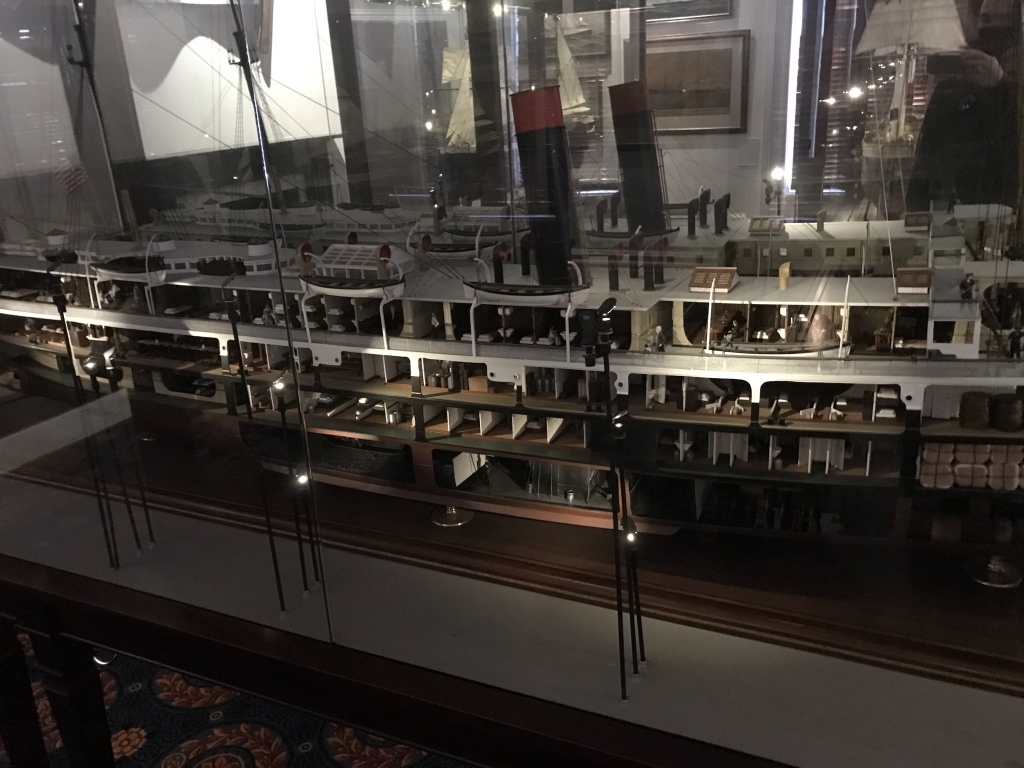
Here's a cutaway model of a cruise ship, Kansas City, which was built in 1889 and was operated by the Savannah Line.
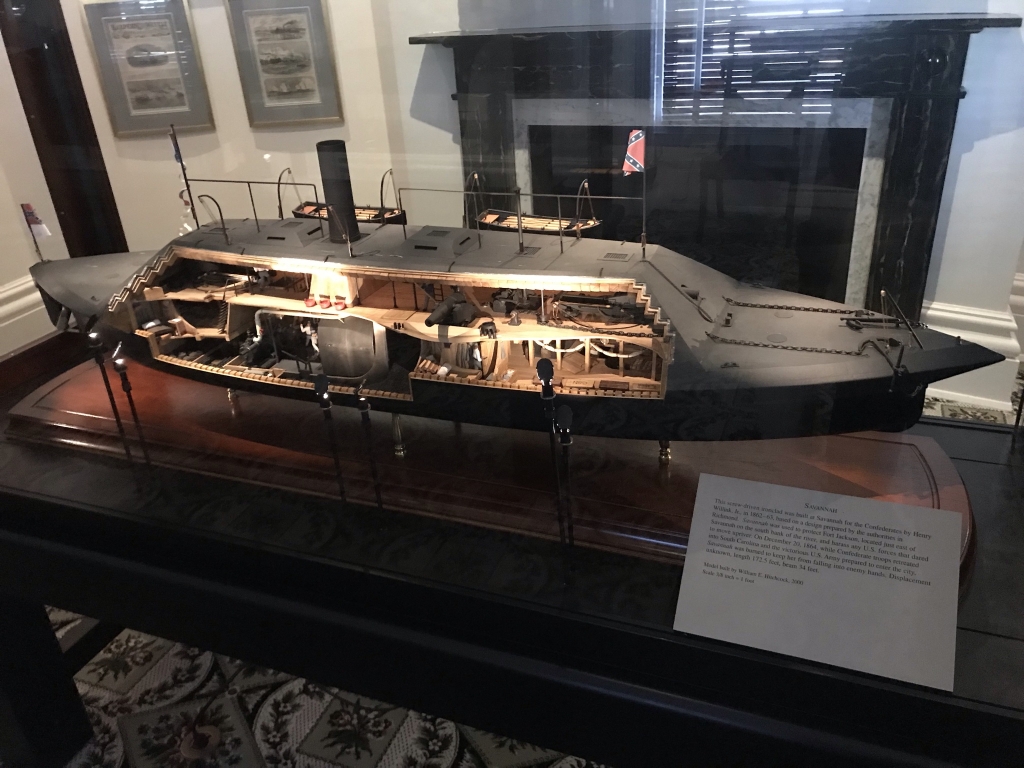
There are a lot of models in here of ships named Savannah. This was an ironclad built for the Confederate Navy in 1862-63.
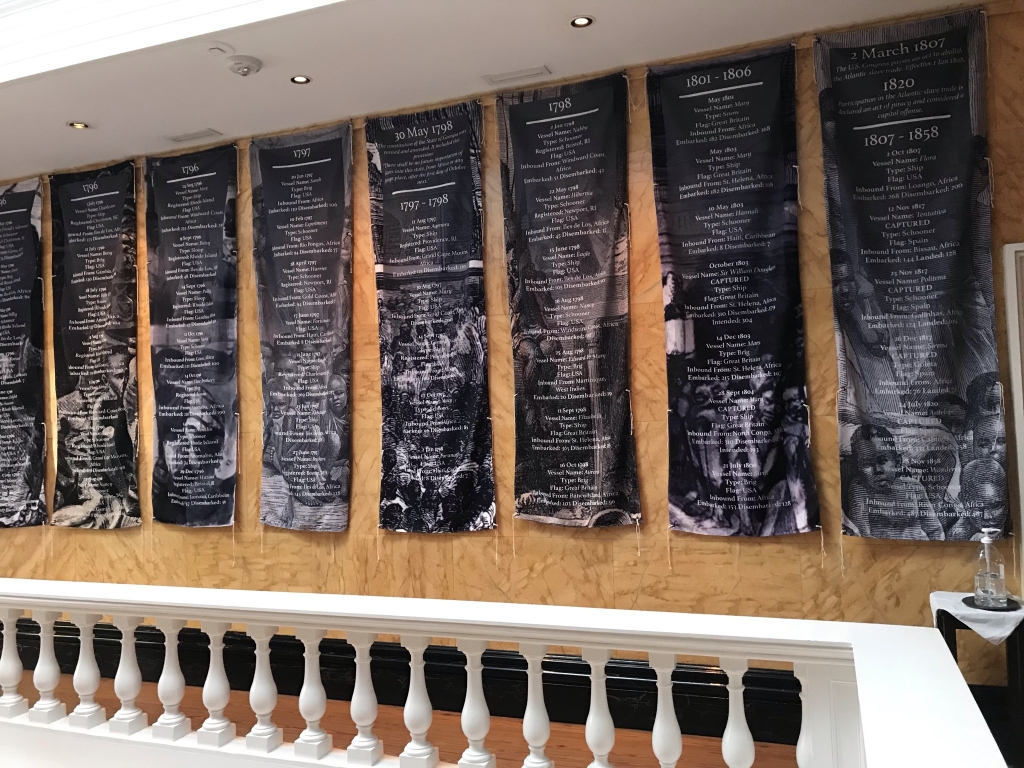
Now we're up on the second floor. This is the upper level of the Human Cargo presentation, in which is the listings of slave ships at the end of the slave trade era. The U.S. government banned the trade effective 1808, and then 1820 declared it piracy and a capital offense. That didn't fully put a stop to the slave trade though, as we can see on the far right banner, as six slave ships arrived in Savannah between 1807 and 1858, and all but one were captured.
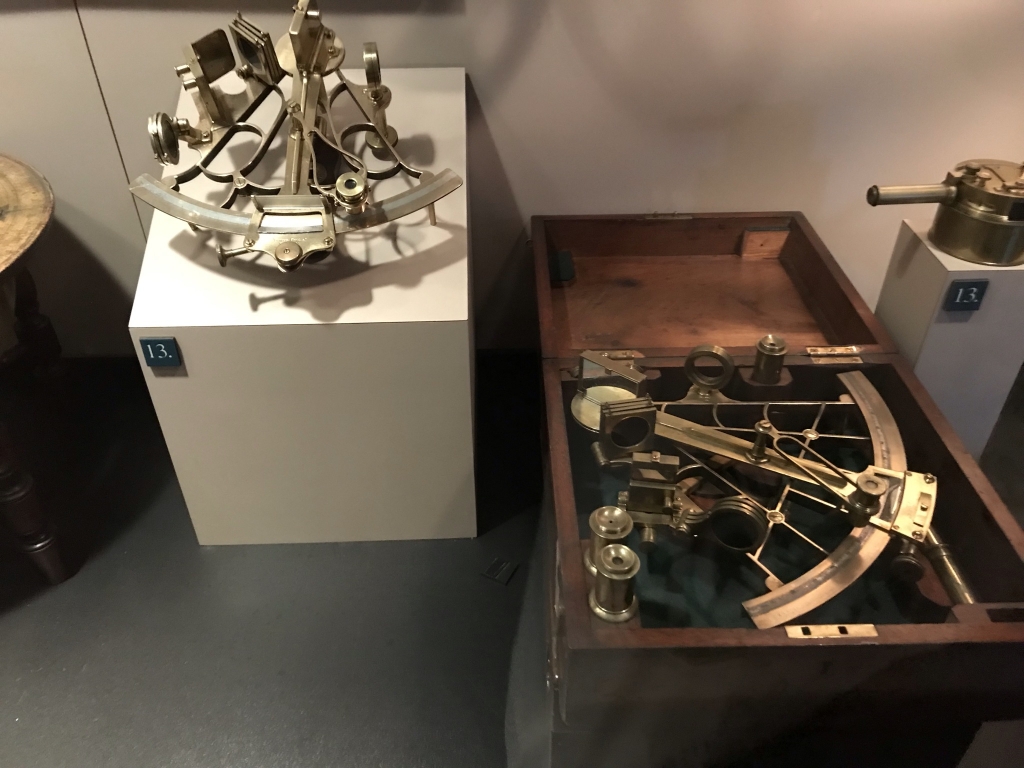
In other second-floor rooms, you can find all manner of tools and instruments used on ships throughout the centuries. Here, you can see navigation equipment, two sextants. These were used for determining latitude and longitude.
I've noticed that in quite a few museums I've recently visited, I've found myself slowing down and taking a closer look at maritime navigation tools like sextants and astrolabes. I think it's because part of me wants to try to build such a thing myself, although I'll probably never get around to actually doing this.
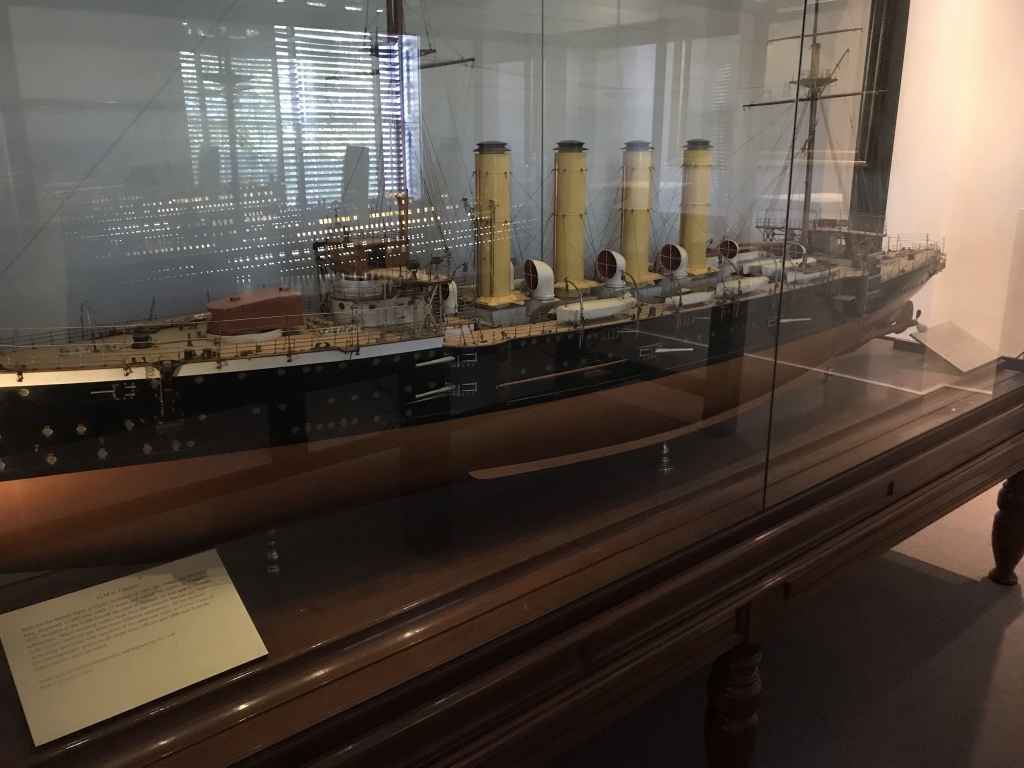
Now we've moved into the turn-of-the-last-century era of steam-powered ships. This here is the HMS Cressy, a British Navy cruiser built in 1901. She was sunk in 1914, during WWI, by German U-Boats.
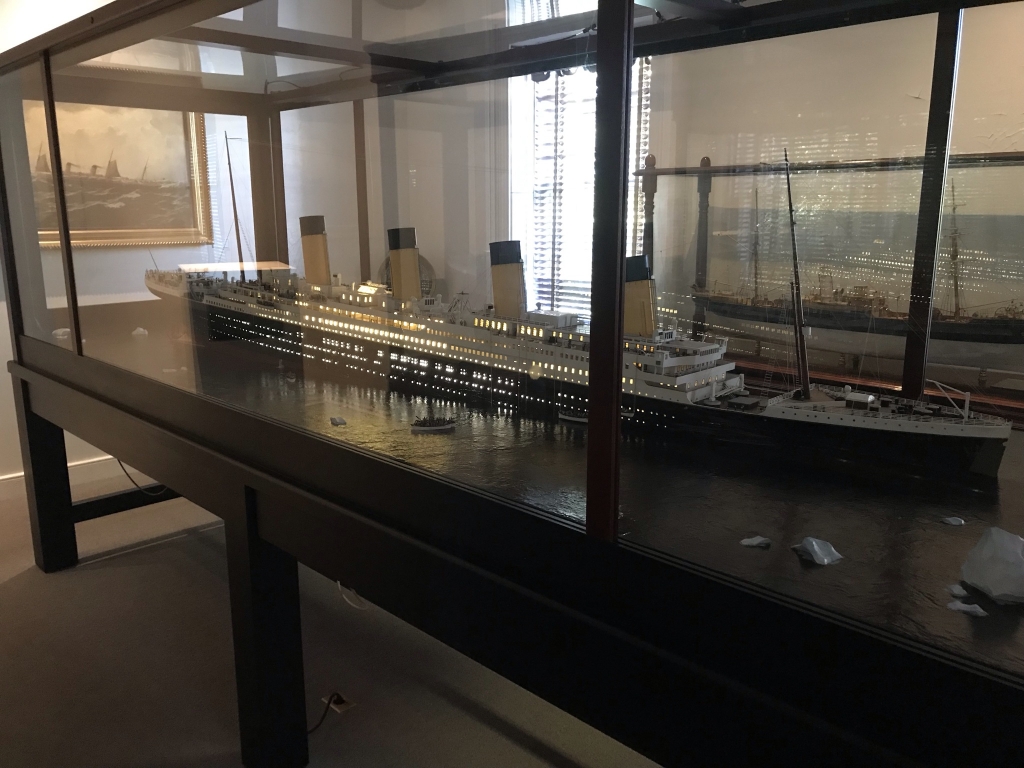
And finally here's the most famous disaster at sea, the RMS Titanic. There have been bigger ships and worse disasters, but none have acquired the legendary status as Titanic's fateful striking an iceberg in 1912. There were 2201 people on board when she started her only voyage, and out of them, 1498 died. That's more than two thirds.
Before leaving the museum, I bought an interesting-looking book from the gift shop: Under the Black Flag: The Romance and Reality of Life Among the Pirates by David Cordingly. After leaving the museum I stopped at another café that could be easily walked to and flipped through the book a bit while enjoying the coffee. I've since read the whole thing and found it to be an easily-readable history of the age of pirates in the 16th, 17th, and 18th centuries, with detailed descriptions of what a pirate's life was really like, comparing the real history to the popular books and movies we're all familiar with.
When it was late enough to look for someplace to eat dinner, I found my way to a British-themed pub called Six Pence Pub, which can be found on the corner of Bull & Perry. The place even had a red British phone booth outside it. Here, first I had to have a pint of Old Speckled Hen, a frothy English brown ale. Dinner was a ham half-sandwich on pumpernickel bread with a salad. That was followed by an Irish Coffee.
My last stop of the night was a bar called World of Beer. I'd been to a place with the same name years earlier in San Antonio. That place was known for having an unbelievably huge selection of beers from around the world, although it unexpectedly went out of business sometime in 2015 or '16. I don't know if there was any relation, but this place in Savannah had the same amazing international range of beer.
I had no less than four beers at World of Beer. The first was a local Savannah brew, a Moon River Taterlicious amber ale. Pretty good. Next up was one of my favorites from Belgium: St. Bernardus Abt 12. This is the dark and strong ale which is almost identical to the highly-rated but nearly-impossible-to-acquire Westvleteren 12. Delicious but definitely not something you can just gulp down. Apparently that wasn't enough for me; I followed the Belgian ale with a Wicked Weed Smores. This one stood out to me because I recognized the brewery, Wicked Weed, which is based in Asheville, North Carolina and whose brewpub I visited during a short trip to Asheville in 2015. Those three beers were intoxicating enough, but there was one more on the menu I had to have...
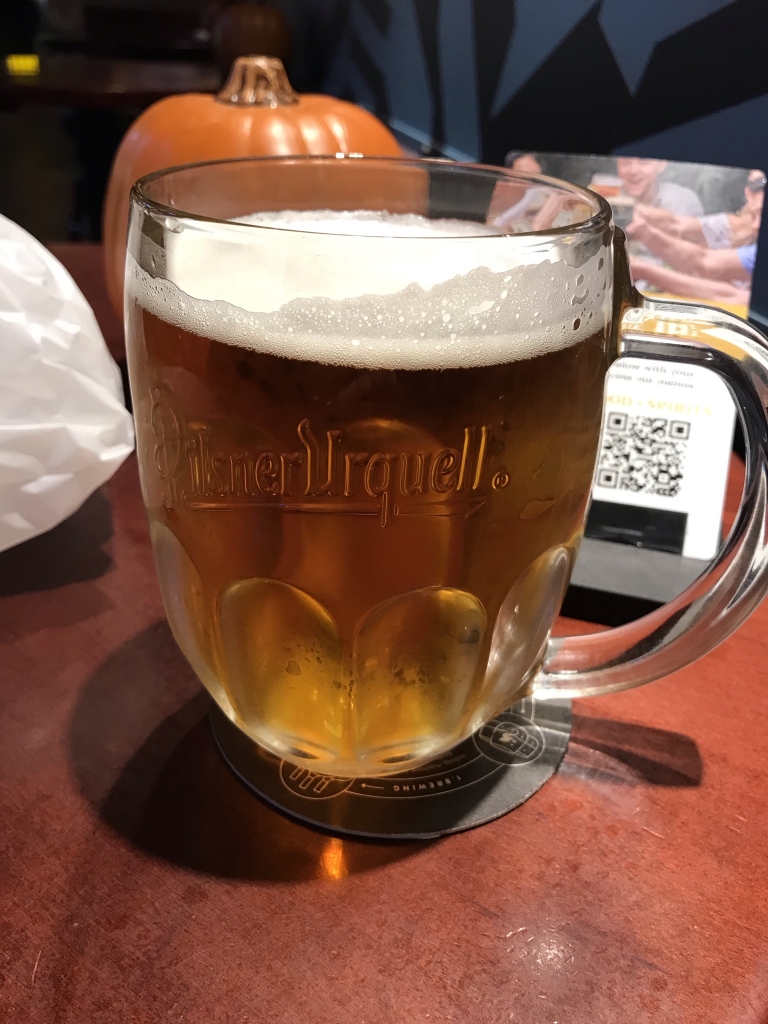
A tankard of Pilsner Urquell, the original Pilsner from Plzen, Czech Republic (Pilsen in German). That mug looks familiar...it's identical to the mug I was drinking Urquell from on my last day in Cluj, Romania two years earlier.
That was four beers in one sitting, one of which was a strong Belgian monastery ale, definitely enough to drink for one night. After this it was time to walk back to the Airbnb house and turn in for the night.
Wednesday, November 3, 2021
I woke up early, before the sun rose, so I could take a bus to the train station. I'd decided I was finally done with Ubers and Lyfts, so I finished off the leftover Chinese food, packed up my bags, and made my way to a bus stop on Martin Luther King, Jr. Blvd. The bus that picked me up had a pretty cheap fare, only $1.50.
The train I was riding that day was called Palmetto, which travels daily between Savannah to New York City. Two and a half months earlier, I rode the last three hours of this same train's journey, from BWI airport to New York Penn Station, which was pretty late at night. This time, I'd be riding the first 90 minutes, from its starting point in Savannah, where it was departing at 8:20am, to North Charleston.
And with that, I had to leave Savannah behind, for now. Overall I was really impressed, and I know I'll have to come back some time. There's so much more to this city I didn't see. After reading Midnight in the Garden of Good and Evil I now know of places like the Mercer House that are in the city's historic center which I didn't think to visit. Just looking at the map I can see there's also a whole lot more to the city than just that central core where I stayed during this trip. There's also Tybee Island which I wanted to see but didn't have time for...I'll certainly return someday soon.
